Paul van Yperen's Blog, page 448
August 7, 2013
Vince Taylor
British ‘Rebel Rocker’ Vince Taylor (1939-1991) was successful - especially in France - during the late 1950s and early 1960s. His trademark was his black leather stage gear and his large Joan of Arc medallion. Taylor’s dynamic on-stage performances can be seen in several films. His reckless lifestyle including acid, speed, and alcohol, quickly took its toll. ‘The black demon of rock’ fell into obscurity, but later he became a cult hero and his 1958 B-side Brand New Cadillac is now a rock and roll classic.
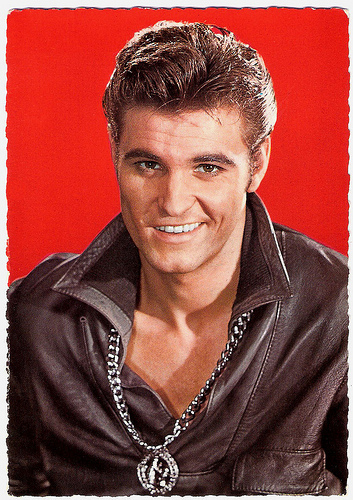
French postcard by E.D.U.G.. no. 231. Photo: Sam Lévin.
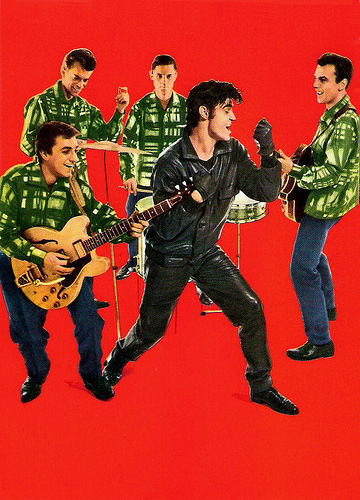
Belgian postcard by SB (S. Best, Antwerpen).
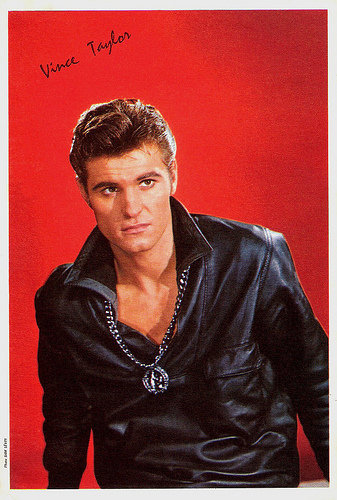
French card. Photo: Sam Lévin.
The Play-Boys
Vince Taylor was born as Brian Maurice Holden in a London suburb in 1939. He spent his early life in Isleworth, Middlesex as the youngest of five children. In 1946, when he was seven years old, the Holdens emigrated to America and settled in New Jersey where his father took work in a coal mine. Around 1955, his sister, Sheila, married Joe Singer (the later Barbera, of cartoon moguls Hanna-Barbera). It was then decided that the whole family would move to California. Brian went to Hollywood High and studied radio and weather reports. He also took flying lessons and got his pilot license. At age 18, impressed by the music of Gene Vincent and Elvis Presley, Taylor began to sing, mostly at amateur gigs. He was good looking, got a great voice and for him the most important was to be able to sing. Barbera, his brother-in-law, became his manager. When Barbera went to London on business he asked Taylor to join him. In London, Taylor went to a coffee bar on Old Compton Street in Soho, The 2I's Coffee Bar, where Tommy Steele was playing. There he met drummer Tony Meehan (later of The Shadows) and bass player Tex Makins. They formed a band called The Play-Boys. After some changes, the final line-up of The Play-Boys was: Bobbie Clarke (drums), John Vance (bass), Alain Le Claire (piano) and Tony Harvey (guitar), who changed on an off with Bob Steel. Whilst looking at a packet of Pall Mall cigarettes he noticed the phrase, 'In hoc signo vinces', and decided that his new stage name would be Vince Taylor (Brian very much liked the actor Robert Taylor). His first singles for Parlophone, I Like Love and Right Behind You Baby, were released in 1958, followed several months later by Pledgin' My Love b/w Brand New Cadillac. Parlophone wasn't very happy with the results of the records and decided to break the contract. Taylor moved to Palette Records and recorded I'll Be Your Hero b/w Jet Black Machine, which was released in 1960.
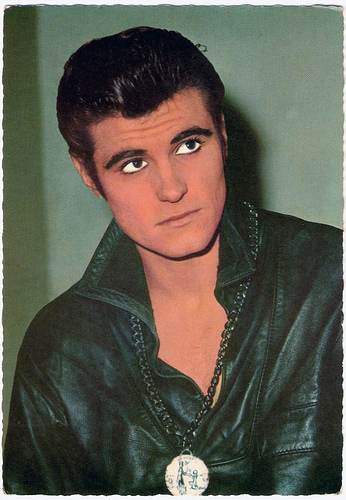
Vintage postcard, no. 25.
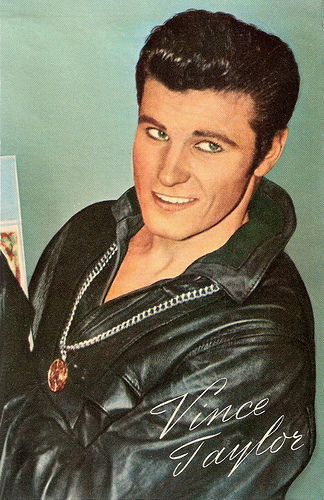
Vintage postcard, serie 6.
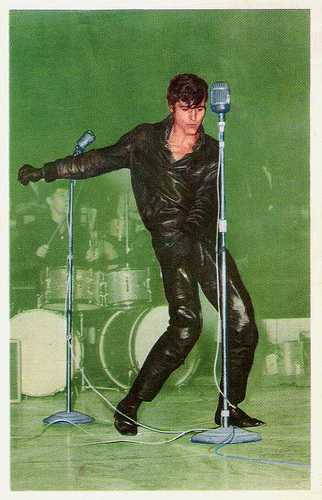
French postcard by Ets. Dagneaux & Cie., Lodelinsart, no.47.47. Presented by Twist - Chewing Gum.
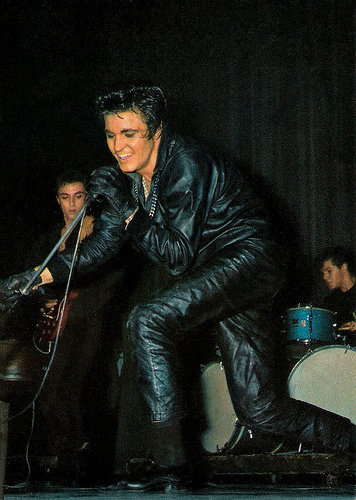
French postcard by Editions P.I., Paris, no. 1078. Photo: Noa.
Black Leather Stage Gear
Vince Taylor’s unpredictable personality, although dynamic on stage, caused several arguments within the band, and The Playboys fired Taylor and changed their name to The Bobbie Clarke Noise. The Noise was contracted to play at the Olympia in Paris in July 1961. The top of the bill was Wee Willie Harris. Despite his sacking Taylor remained friendly with the band and he asked if he could come to Paris too. Here he dressed up for the sound check in his trade mark black leather stage gear, and added a chain around his neck with a Joan of Arc medallion, which he had bought on arrival at Calais. (According to Jacques Mercier on his website on Vince Taylor, Taylor had found the gear “walking through the streets of London, he stopped dead in front of a winter sports shop window, a model dressed in black leather from head to toe, caught his eye. He bought the whole kit and wore it the same night on stage, increasing the reactions and enthusiasm of the public.”) Reportedly he gave such an extraordinary performance at the sound check in Paris, that the organizers decided to put Taylor at the top of the bill for both shows. As a result of these two shows, Eddie Barclay signed him to a six-year record deal on the Barclay label. During 1961 and 1962, Taylor toured Europe with Clarke's band, once again called Vince Taylor and his Playboys. Between gigs they recorded several EP’s and an album of 20 songs, at Barclay Studios in Paris; these songs included covers of Sweet Little Sixteen and Long Tall Sally. He also performed in such films as Le quatrième sexe/The Fourth Sex (Alphonse Gimeno, 1961), Paris je t'aime/Paris I Love You (Guy Pérol, 1962) and Universo di notte/Universe of the Night (Alessandro Jacovoni, 1962). By the end of 1962, Vince Taylor and The Playboys were the top of the bill at the Olympia. Sylvie Vartan was the opening act. Despite of an on-stage rapport with The Playboys, the off-stage relationship faltered: as a result, the band once more broke up. Taylor played several engagements backed by the English band The Echoes (who also backed Gene Vincent whenever he played the UK), but he still presented the band as The Playboys.
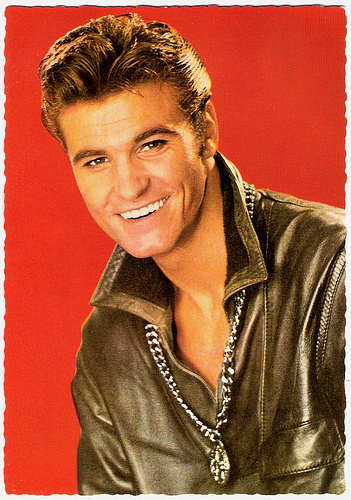
French postcard by E.D.U.G.. no. 218. Photo: Sam Lévin.
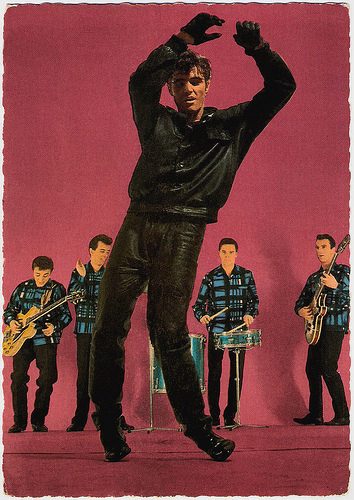
French postcard by E.D.U.G., no. 212. Photo: Herman Léonard / Disques Barclay.
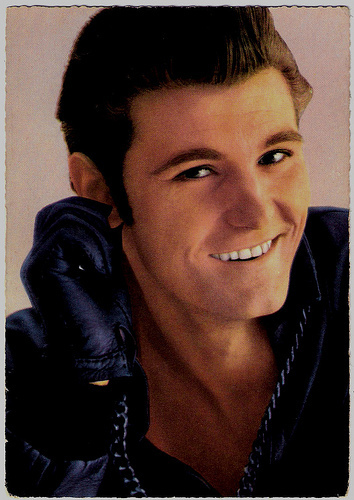
German postcard by ISV. no. H 90.
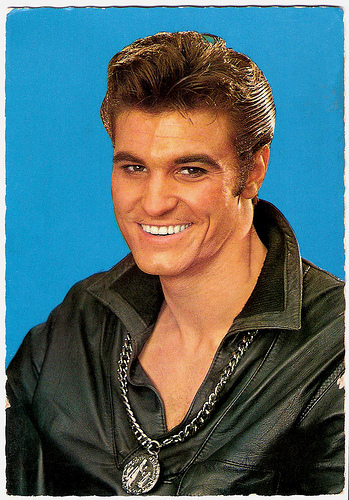
French postcard by E.D.U.G.. no. 232. Photo: Sam Lévin.
The Immaculate Conception of British Rock and Roll
In 1964, Vince Taylor released a new single Memphis Tennessee b/w A Shot of Rhythm and Blues on the Barclay label. A new highpoint was reached later that year when Taylor played as the opening act for The Rolling Stones on their first concert at the Olympia in Paris. Then things started to tumble into chaos as Taylor, his mind badly affected by a combination of drugs and alcohol, became increasingly erratic both on-stage and off. At an important concert in London Taylor declared he was the biblical prophet Matthew in front of a large audience. The band disbanded and Taylor joined a religious movement. Later, Clarke was involved in a comeback for his friend Taylor, a one month tour across France, billed as Vince Taylor and Bobbie Clarke backed by Les Rockers. More often than not, he was bafflingly incoherent and erratic on-stage. Eddie Barclay gave a new chance to Taylor who recorded again and performed intermittently throughout the 1970’s and 1980’s, until his death. He also appeared in two films, Rebelote (Jacques Richard, 1983) with Jean-Jacques Léaud, and the Belgian comedy Max (Freddy Coppens, 1984). His song Brand New Cadillac has been covered by many other artists, such as The Renegades, The Shamrocks and The Clash on their 1979 album London Calling. Taylor was a major source of inspiration in 1972 for David Bowie's Ziggy Stardust, the ‘Leper Messiah.’ Known as the Black Leather Rebel, Taylor may have been the first rocker to dress in head-to-toe cowhide. To the late Joe Strummer of The Clash, he was the immaculate conception of British rock and roll: "Before him there was nothing. He was a miracle." During his last years, Taylor lived in Switzerland and worked as an airplane mechanic. He purportedly said it was the happiest time of his life. At the age of 52, Vince Taylor died from cancer in 1991 in Lutry, Switzerland. He was buried in Lausanne, Switzerland. Taylor had a son, Ty Holden, who was in the indie band Crown of Thorns, managed by Miles Copeland. Ty Holden is now a DJ on the London underground dance scene.
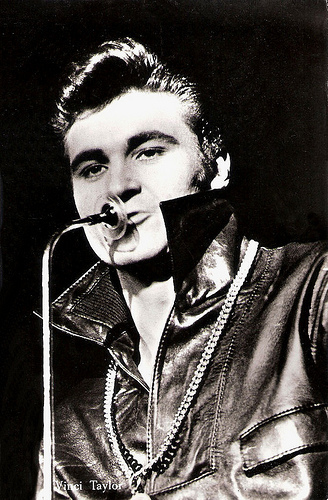
Dutch postcard by gebr. Spanjersberg N.V., Rotterdam (Sparo), no. 1010.
Vince Taylor and the Play-Boys bring Shakin' All Over in 1960. Source: mjdropsey (YouTube).
Vince Taylor sings Brand New Cadillac in 1979. Source: Dailymotion.
Sources: Jacques Mercier (iFrance), Steve Leggett (All Music), James Sullivan (Spinner), Dik de Heer (BlackCat Rockabilly), Wikipedia and

French postcard by E.D.U.G.. no. 231. Photo: Sam Lévin.

Belgian postcard by SB (S. Best, Antwerpen).

French card. Photo: Sam Lévin.
The Play-Boys
Vince Taylor was born as Brian Maurice Holden in a London suburb in 1939. He spent his early life in Isleworth, Middlesex as the youngest of five children. In 1946, when he was seven years old, the Holdens emigrated to America and settled in New Jersey where his father took work in a coal mine. Around 1955, his sister, Sheila, married Joe Singer (the later Barbera, of cartoon moguls Hanna-Barbera). It was then decided that the whole family would move to California. Brian went to Hollywood High and studied radio and weather reports. He also took flying lessons and got his pilot license. At age 18, impressed by the music of Gene Vincent and Elvis Presley, Taylor began to sing, mostly at amateur gigs. He was good looking, got a great voice and for him the most important was to be able to sing. Barbera, his brother-in-law, became his manager. When Barbera went to London on business he asked Taylor to join him. In London, Taylor went to a coffee bar on Old Compton Street in Soho, The 2I's Coffee Bar, where Tommy Steele was playing. There he met drummer Tony Meehan (later of The Shadows) and bass player Tex Makins. They formed a band called The Play-Boys. After some changes, the final line-up of The Play-Boys was: Bobbie Clarke (drums), John Vance (bass), Alain Le Claire (piano) and Tony Harvey (guitar), who changed on an off with Bob Steel. Whilst looking at a packet of Pall Mall cigarettes he noticed the phrase, 'In hoc signo vinces', and decided that his new stage name would be Vince Taylor (Brian very much liked the actor Robert Taylor). His first singles for Parlophone, I Like Love and Right Behind You Baby, were released in 1958, followed several months later by Pledgin' My Love b/w Brand New Cadillac. Parlophone wasn't very happy with the results of the records and decided to break the contract. Taylor moved to Palette Records and recorded I'll Be Your Hero b/w Jet Black Machine, which was released in 1960.

Vintage postcard, no. 25.

Vintage postcard, serie 6.

French postcard by Ets. Dagneaux & Cie., Lodelinsart, no.47.47. Presented by Twist - Chewing Gum.

French postcard by Editions P.I., Paris, no. 1078. Photo: Noa.
Black Leather Stage Gear
Vince Taylor’s unpredictable personality, although dynamic on stage, caused several arguments within the band, and The Playboys fired Taylor and changed their name to The Bobbie Clarke Noise. The Noise was contracted to play at the Olympia in Paris in July 1961. The top of the bill was Wee Willie Harris. Despite his sacking Taylor remained friendly with the band and he asked if he could come to Paris too. Here he dressed up for the sound check in his trade mark black leather stage gear, and added a chain around his neck with a Joan of Arc medallion, which he had bought on arrival at Calais. (According to Jacques Mercier on his website on Vince Taylor, Taylor had found the gear “walking through the streets of London, he stopped dead in front of a winter sports shop window, a model dressed in black leather from head to toe, caught his eye. He bought the whole kit and wore it the same night on stage, increasing the reactions and enthusiasm of the public.”) Reportedly he gave such an extraordinary performance at the sound check in Paris, that the organizers decided to put Taylor at the top of the bill for both shows. As a result of these two shows, Eddie Barclay signed him to a six-year record deal on the Barclay label. During 1961 and 1962, Taylor toured Europe with Clarke's band, once again called Vince Taylor and his Playboys. Between gigs they recorded several EP’s and an album of 20 songs, at Barclay Studios in Paris; these songs included covers of Sweet Little Sixteen and Long Tall Sally. He also performed in such films as Le quatrième sexe/The Fourth Sex (Alphonse Gimeno, 1961), Paris je t'aime/Paris I Love You (Guy Pérol, 1962) and Universo di notte/Universe of the Night (Alessandro Jacovoni, 1962). By the end of 1962, Vince Taylor and The Playboys were the top of the bill at the Olympia. Sylvie Vartan was the opening act. Despite of an on-stage rapport with The Playboys, the off-stage relationship faltered: as a result, the band once more broke up. Taylor played several engagements backed by the English band The Echoes (who also backed Gene Vincent whenever he played the UK), but he still presented the band as The Playboys.

French postcard by E.D.U.G.. no. 218. Photo: Sam Lévin.

French postcard by E.D.U.G., no. 212. Photo: Herman Léonard / Disques Barclay.

German postcard by ISV. no. H 90.

French postcard by E.D.U.G.. no. 232. Photo: Sam Lévin.
The Immaculate Conception of British Rock and Roll
In 1964, Vince Taylor released a new single Memphis Tennessee b/w A Shot of Rhythm and Blues on the Barclay label. A new highpoint was reached later that year when Taylor played as the opening act for The Rolling Stones on their first concert at the Olympia in Paris. Then things started to tumble into chaos as Taylor, his mind badly affected by a combination of drugs and alcohol, became increasingly erratic both on-stage and off. At an important concert in London Taylor declared he was the biblical prophet Matthew in front of a large audience. The band disbanded and Taylor joined a religious movement. Later, Clarke was involved in a comeback for his friend Taylor, a one month tour across France, billed as Vince Taylor and Bobbie Clarke backed by Les Rockers. More often than not, he was bafflingly incoherent and erratic on-stage. Eddie Barclay gave a new chance to Taylor who recorded again and performed intermittently throughout the 1970’s and 1980’s, until his death. He also appeared in two films, Rebelote (Jacques Richard, 1983) with Jean-Jacques Léaud, and the Belgian comedy Max (Freddy Coppens, 1984). His song Brand New Cadillac has been covered by many other artists, such as The Renegades, The Shamrocks and The Clash on their 1979 album London Calling. Taylor was a major source of inspiration in 1972 for David Bowie's Ziggy Stardust, the ‘Leper Messiah.’ Known as the Black Leather Rebel, Taylor may have been the first rocker to dress in head-to-toe cowhide. To the late Joe Strummer of The Clash, he was the immaculate conception of British rock and roll: "Before him there was nothing. He was a miracle." During his last years, Taylor lived in Switzerland and worked as an airplane mechanic. He purportedly said it was the happiest time of his life. At the age of 52, Vince Taylor died from cancer in 1991 in Lutry, Switzerland. He was buried in Lausanne, Switzerland. Taylor had a son, Ty Holden, who was in the indie band Crown of Thorns, managed by Miles Copeland. Ty Holden is now a DJ on the London underground dance scene.

Dutch postcard by gebr. Spanjersberg N.V., Rotterdam (Sparo), no. 1010.
Vince Taylor and the Play-Boys bring Shakin' All Over in 1960. Source: mjdropsey (YouTube).
Vince Taylor sings Brand New Cadillac in 1979. Source: Dailymotion.
Sources: Jacques Mercier (iFrance), Steve Leggett (All Music), James Sullivan (Spinner), Dik de Heer (BlackCat Rockabilly), Wikipedia and
Published on August 07, 2013 23:00
August 6, 2013
Dranem
Dranem (1869-1935) was a French comic singer, music hall, stage and film actor. He started film career with silent shorts for Pathé Frères and played in a series of early sound films by Alice Guy. In the early 1930s he returned to the cinema for screen roles featuring his popular singing routines.
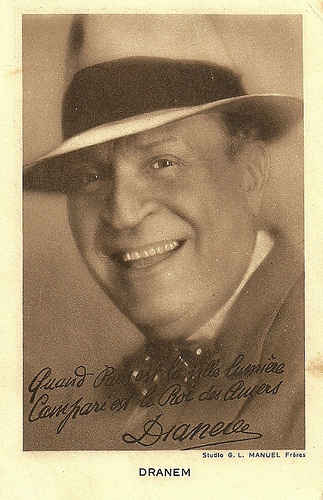
French postcard. Photo: Studio G.L. Manuel Frères. Caption: "Quand Paris est la ville lumière, Campari est le Roi des Amers." (When Paris is the capital of light, Campari is the king of the bitters.)
Leading Music Hall Entertainer
Dranem or Armand Dranem was born Armand Ménard in Paris, in 1869. He began working as an apprentice jeweller in a local shop before embarking on a career in entertainment. Adopting the singular stage name of Dranem, an anagram of Menard, he made his debut performance in 1894 at the Concert de l'Epqoue. In 1895, he performed with fellow newcomers Félix Mayol and Max Dearly in the Concert Parisien from where he went on to become a leading music hall entertainer in his own comic absurdist genre. In 1899, he was signed to perform at the famous Eldorado Club where he appeared regularly for the next twenty years. Dranem's comedic singing routine brought a loyal following and his work made him a very wealthy man. In 1910 he purchased the Château de Ris in the town of Ris-Orangis, south of Paris. He established a charitable foundation to operate the large building as a senior citizens home for retired performers. On the grounds, a bandstand and an open-air theatre provided entertainment. His Dranem Foundation continued to operate until the year 2000 and the property remains a government operated retirement home open to all members of the public. During World War I, Dranem continued his benevolence by performing for the troops at music halls and for wounded soldiers at military hospitals.
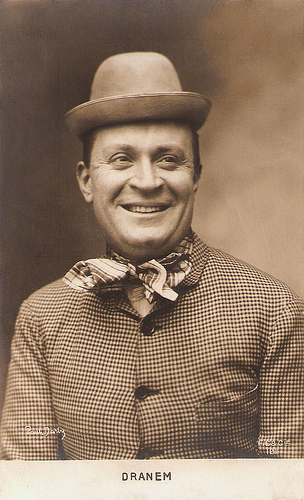
French postcard by F.C. & Cie., no. 121. Photo: Paul Darly.
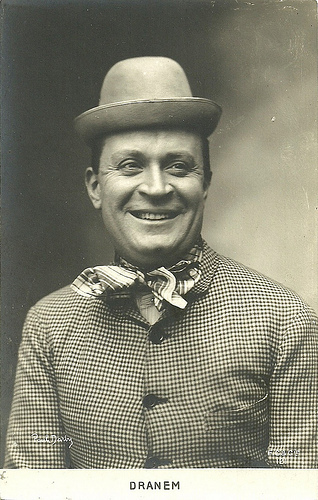
French postcard. Photo: Paul Darly.
Pathé Silents
Active in variety shows, café-concerts, and as a performer in operettas, Dranem also acted and sang in live theatre and in film. According to Alison McMahan, Dranem already acted in 1900 in the Pathé Frères silent Ma Tante/My Aunt, though Laurent Mannoni in Encyclopedia of Early Cinema dates this film as 1903. According to Mannoni, Pathé launched his film career in 1901 with Le salut de Dranem/Dranem's Salute to the Audience (Ferdinand Zecca, 1901), followed by several silent shorts by Pathé. These shorts showed sometimes Dranem in drag, and often as the title character as well. Mannoni mentions: Histoire grivoise racontée par une concierge/Saucy Story as Told by the Concierge (1902), Ma Tante/My Aunt (Ferdinand Zecca, 1903), Le mitron/The Baker's Boy (Ferdinand Zecca, 1904), Le rêve de Dranem/Dranem's Dream (Ferdinand Zecca, 1905) to Le tondeur galant/The Gallant Shearer (1912). McMahan also mentions Man Eating Pomegranates (1903). IMDb also lists Les souliers de Dranem/Dranem's Shoes (Ferdinand Zecca, 1908), Dranem fait ressemeler ses ribouis (1910), Le mariage de Dranem/Dranem's Marriage (Ferdinand Zecca, 1912) and Dranem sténo-dactyle/Dranem as shorthand dactyle (1912), and the Molière adaptation Le médecin malgré lui/The doctor in spite of himself (1913). In 1905, Dranem performed in a series of 11 early sound films, 'phonoscènes'. They were produced by Gaumont and directed by Alice Guy. The titles were Allumeur Marche/Lighter-on, Le trou de mon quai/My Quay's Hole, Valsons, V'la retameur/V'la the tinker, Les p'tits pois/Little Peas, L'enfant du cordonnier/The child of a shoemaker, Etre légume/Being vegetable, Le cucurbitacée/Cucurbit, Le boléro cosmopolite/The cosmopolitan bolero, Bonsoir, M'sieurs, dames/Good evening ladies and Gentlemen, Le Vrai Jiu-jitsu/Dranem Performs 'The True Jiu-Jitsu', and Five O'Clock Tea.
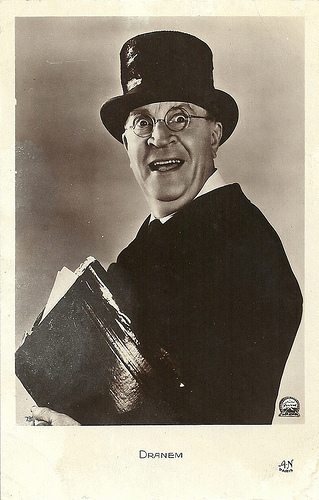
French postcard by A.N., Paris, no. 79. Photo: Paramount.
A Misfortunate Ostrich Breeder
Alison MacMahan writes, "Dranem was a very energetic performer, moving around the entire stage, combining whole body language with pantomime and caricature. Although he wore the same 'bum' or 'clown' costume in each of his films, he had a different prop (a bucket, a poncho, a vegetable) in each one." In the 1920s, Dranem only acted in two films. He had a small part in La clé de voute/The keystone (Roger Lion, 1925) with Gina Palerme, but he played the lead in the late silent comedy J'ai l'noir/Le suicide Dranem (Max de Rieux, 1929), in which Dranem is a misfortunate ostrich breeder. The advent of synchronized sound film in the late 1920s made Dranem much in demand for screen roles featuring his singing routines. In the 1930s he played in some 13 films. In several he played the lead, such as La poule/The Hen (René Guissart, 1932) with Arlette Marchal, and Ah! Quelle gare!/Ah! What a station! (René Guissart, 1933), or at least as the main male antagonist. He acted in sound film until his death. Dranem died in Paris in 1935 at the age of sixty-six and was buried at the Château de Ris.
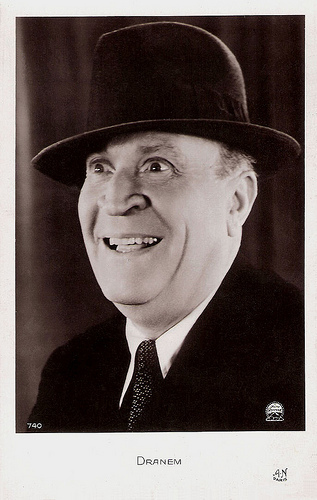
French postcard by A.N., Paris, no. 740. Photo: Paramount.
Sources: Alison McMahan, Alice Guy-Blaché. Lost Visionary of the Cinema, Laurent Mannoni, Encyclopedia of Early Cinema, Wikipedia (English and French), and

French postcard. Photo: Studio G.L. Manuel Frères. Caption: "Quand Paris est la ville lumière, Campari est le Roi des Amers." (When Paris is the capital of light, Campari is the king of the bitters.)
Leading Music Hall Entertainer
Dranem or Armand Dranem was born Armand Ménard in Paris, in 1869. He began working as an apprentice jeweller in a local shop before embarking on a career in entertainment. Adopting the singular stage name of Dranem, an anagram of Menard, he made his debut performance in 1894 at the Concert de l'Epqoue. In 1895, he performed with fellow newcomers Félix Mayol and Max Dearly in the Concert Parisien from where he went on to become a leading music hall entertainer in his own comic absurdist genre. In 1899, he was signed to perform at the famous Eldorado Club where he appeared regularly for the next twenty years. Dranem's comedic singing routine brought a loyal following and his work made him a very wealthy man. In 1910 he purchased the Château de Ris in the town of Ris-Orangis, south of Paris. He established a charitable foundation to operate the large building as a senior citizens home for retired performers. On the grounds, a bandstand and an open-air theatre provided entertainment. His Dranem Foundation continued to operate until the year 2000 and the property remains a government operated retirement home open to all members of the public. During World War I, Dranem continued his benevolence by performing for the troops at music halls and for wounded soldiers at military hospitals.

French postcard by F.C. & Cie., no. 121. Photo: Paul Darly.

French postcard. Photo: Paul Darly.
Pathé Silents
Active in variety shows, café-concerts, and as a performer in operettas, Dranem also acted and sang in live theatre and in film. According to Alison McMahan, Dranem already acted in 1900 in the Pathé Frères silent Ma Tante/My Aunt, though Laurent Mannoni in Encyclopedia of Early Cinema dates this film as 1903. According to Mannoni, Pathé launched his film career in 1901 with Le salut de Dranem/Dranem's Salute to the Audience (Ferdinand Zecca, 1901), followed by several silent shorts by Pathé. These shorts showed sometimes Dranem in drag, and often as the title character as well. Mannoni mentions: Histoire grivoise racontée par une concierge/Saucy Story as Told by the Concierge (1902), Ma Tante/My Aunt (Ferdinand Zecca, 1903), Le mitron/The Baker's Boy (Ferdinand Zecca, 1904), Le rêve de Dranem/Dranem's Dream (Ferdinand Zecca, 1905) to Le tondeur galant/The Gallant Shearer (1912). McMahan also mentions Man Eating Pomegranates (1903). IMDb also lists Les souliers de Dranem/Dranem's Shoes (Ferdinand Zecca, 1908), Dranem fait ressemeler ses ribouis (1910), Le mariage de Dranem/Dranem's Marriage (Ferdinand Zecca, 1912) and Dranem sténo-dactyle/Dranem as shorthand dactyle (1912), and the Molière adaptation Le médecin malgré lui/The doctor in spite of himself (1913). In 1905, Dranem performed in a series of 11 early sound films, 'phonoscènes'. They were produced by Gaumont and directed by Alice Guy. The titles were Allumeur Marche/Lighter-on, Le trou de mon quai/My Quay's Hole, Valsons, V'la retameur/V'la the tinker, Les p'tits pois/Little Peas, L'enfant du cordonnier/The child of a shoemaker, Etre légume/Being vegetable, Le cucurbitacée/Cucurbit, Le boléro cosmopolite/The cosmopolitan bolero, Bonsoir, M'sieurs, dames/Good evening ladies and Gentlemen, Le Vrai Jiu-jitsu/Dranem Performs 'The True Jiu-Jitsu', and Five O'Clock Tea.

French postcard by A.N., Paris, no. 79. Photo: Paramount.
A Misfortunate Ostrich Breeder
Alison MacMahan writes, "Dranem was a very energetic performer, moving around the entire stage, combining whole body language with pantomime and caricature. Although he wore the same 'bum' or 'clown' costume in each of his films, he had a different prop (a bucket, a poncho, a vegetable) in each one." In the 1920s, Dranem only acted in two films. He had a small part in La clé de voute/The keystone (Roger Lion, 1925) with Gina Palerme, but he played the lead in the late silent comedy J'ai l'noir/Le suicide Dranem (Max de Rieux, 1929), in which Dranem is a misfortunate ostrich breeder. The advent of synchronized sound film in the late 1920s made Dranem much in demand for screen roles featuring his singing routines. In the 1930s he played in some 13 films. In several he played the lead, such as La poule/The Hen (René Guissart, 1932) with Arlette Marchal, and Ah! Quelle gare!/Ah! What a station! (René Guissart, 1933), or at least as the main male antagonist. He acted in sound film until his death. Dranem died in Paris in 1935 at the age of sixty-six and was buried at the Château de Ris.

French postcard by A.N., Paris, no. 740. Photo: Paramount.
Sources: Alison McMahan, Alice Guy-Blaché. Lost Visionary of the Cinema, Laurent Mannoni, Encyclopedia of Early Cinema, Wikipedia (English and French), and
Published on August 06, 2013 23:00
August 5, 2013
Maharadjahens Yndlingshustru/The Maharaja’s Favourite Wife
Maharadjahens Yndlingshustru/The Maharaja’s Favourite Wife (Robert Dinesen, Svend Gade, 1917) was a Danish orientalist melodrama produced by the Nordisk studio. The stars were Gunnar Tolnaes and Lily Jacobson. The film was so popular that it had a Danish sequel in 1919, again with Tolnaes and Jacobson, and a German sequel in 1921.

German postcard by Photochemie, Berlin, no. K 2992. Photo: Nordisk. Gunnar Tolnaes and Lilly Jacobson in Die Lieblingsfrau des Maharadscha/Maharadjahens Yndlingshustru/The Maharaja’s Favourite Wife (1917).
Gunnar Tolnaes
The Danish film industry was an international super power in the 1910s and the Nordisk productions were the most successful of them all - especially in Germany. The studio heads at Nordisk hoped that Norwegian-born actor silent film star Gunnar Tolnaes would become as popular as their biggest star, Valdemar Psilander. Tolnaes had his most famous performance for Nordisk in Maharadjahens Yndlingshustru/The Maharaja’s Favourite Wife (Robert Dinesen, Svend Gade, 1917). He played an Indian prince, and Lily Jacobson played his love interest, the Danish Elly von Langen.
In 1913, Tolnaes started his film career for the Swedish company Svenska Biografteatern AB in Stockholm and worked there with legendary director Victor Sjöström. They made the silent dramas Halvblod/Half Breed (Victor Sjöström, 1913) with Karin Molander, Gatans barn/Children of the Streets (Victor Sjöström, 1914) starring Lili Beck, and En av de många/One of the Many (Victor Sjöström, 1915). He also worked with the other great director of the silent Swedish cinema, Mauritz Stiller.
Then Tolnaes moved to Denmark, where he was offered a contract at the Nordisk studio. He was immediately successful with Doktor X/Doctor X (1915) directed by Robert Dinesen. He had an impressive career in Denmark in such films as the science fiction film Himmelskibet/400 Million Miles From Earth (Holger-Madsen, 1918) and of course Maharadjahens Yndlingshustru/The Maharaja’s Favourite Wife and its sequel.

German postcard by Photochemie, Berlin, no. K 2995. Photo: Nordisk.

German postcard by Photochemie, Berlin. Photo: Nordisk.
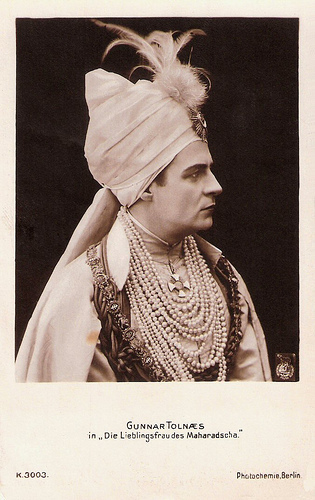
German postcard by Photochemie, Berlin, no. K 3003. Photo: Nordisk.
Lilly Jacobsson
In 1916 Nordisk was looking for a new female star. Swedish actress Lilly Jacobson was chosen from hundreds of competitors and became the leading actress in Maharadjahens Yndlingshustru/The Maharaja’s Favourite Wife.
Jacobsson had already starred in Swedish and Danish silent films by such directors as Eric Malmberg, Mauritz Stiller and Holger-Madsen. In Maharadjahens Yndlingshustru she performed as Elly von Langen who enters the harem of an Indian Maharaja. In the following years, Jacobsson played in various Danish films, mostly directed by Holger-Madsen. These films include the science fiction-film Himmelskibet/400 Million Miles From Earth (Holger-Madsen, 1918) starring Nils Asther, Folkets ven/Friend of the People (Holger-Madsen, 1918), and Mod Lyset/Towards the Light (Holger-Madsen, 1918) starring Asta Nielsen.
She played a cold, partying woman who neglects religion, but later on repents and becomes the wife of a preacher man (Alf Blütecher) who takes care of the poor. The film eventually resulted in Jacobson playing Ophelia in Asta’s famous production of Hamlet (Svend Gade, Heinz Schall, 1921), in which Nielsen played the title role herself. In 1919 Lilly Jacobson married director Corbett Edwards in Odense (Denmark), which ended her film career.
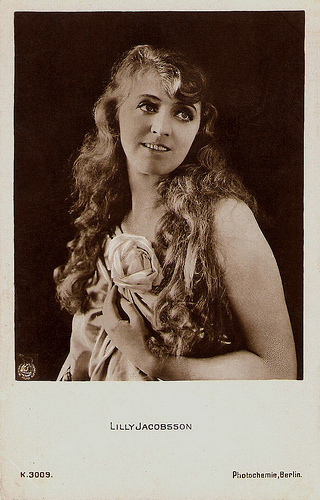
German postcard by Photochemie, Berlin, no. K. 3009. Photo: Nordisk.
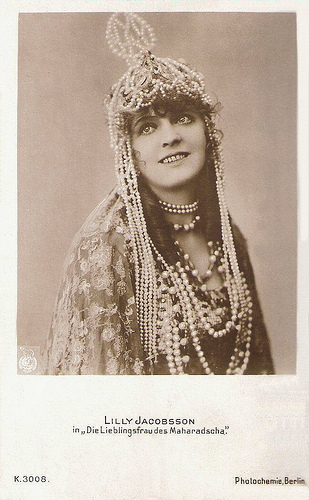
German postcard by Photochemie, Berlin, no. K. 3008. Photo: Nordisk.
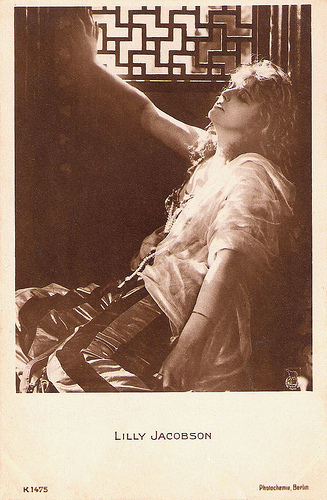
German postcard by Photochemie, Berlin, no. K.1475. Photo: Nordisk.
German Version
At IMDb , F Gwynplaine MacIntyre reviews: "I give this movie credit for several genuine surprises: it sets up a very obviously formulaic plot, and then contradicts the formula several times. Quite a few movies from this period (both European and American) depicted exotic foreigners as swarthy villains, keen on defiling white women. I was intrigued that the maharajah in this movie seems to be all set to fit neatly into that stereotype, but then turns out to be a virtuous character (by his own culture's rules) who's meant to receive the audience's sympathy. The photography and art direction are superb, and the editing is impressive."
Maharadjahens Yndlingshustru/The Maharaja’s Favourite Wife was so popular that Nordisk made a sequel: Maharadjahens Yndlingshustru II/The Maharaja's Favourite Wife II (August Blom, 1919). It features a different set of characters. In 1921 the German studio PAGU would produce another sequel Die Lieblingsfrau des Maharadschas - 3. Teil/The Maharajah's Favourite Wife III (Max Mack, 1921) in which Aud Egede Nissen replaced Jacobson.
Die Lieblingsfrau des Maharadscha was Tolnaes' first German film. He then alternated acting in German films with acting in Danish films, until the end of the silent era. Most of his Danish films in the 1920s were directed by A.W. Sandberg.
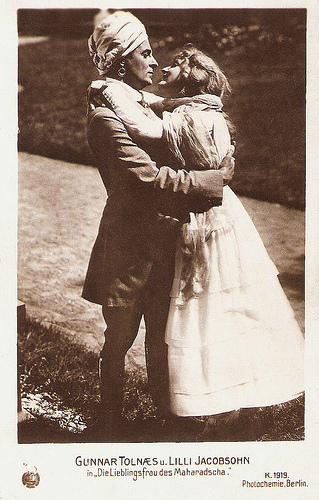
German postcard by Photochemie, Berlin, no. K1919. Photo: Nordisk.
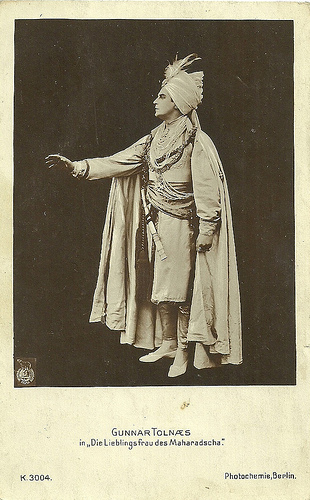
German postcard by Photochemie, Berlin, no. K 3004. Photo: Nordisk.
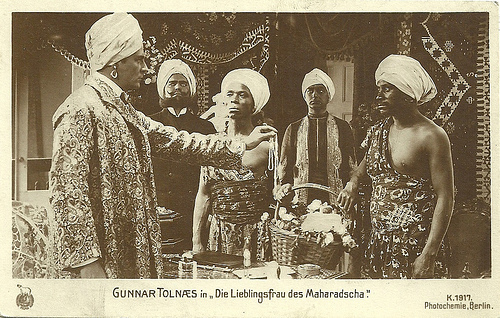
German postcard by Photochemie, Berlin, no. K 1917. Photo: Nordisk.
Sources: Wikipedia (German) and IMDb,

German postcard by Photochemie, Berlin, no. K 2992. Photo: Nordisk. Gunnar Tolnaes and Lilly Jacobson in Die Lieblingsfrau des Maharadscha/Maharadjahens Yndlingshustru/The Maharaja’s Favourite Wife (1917).
Gunnar Tolnaes
The Danish film industry was an international super power in the 1910s and the Nordisk productions were the most successful of them all - especially in Germany. The studio heads at Nordisk hoped that Norwegian-born actor silent film star Gunnar Tolnaes would become as popular as their biggest star, Valdemar Psilander. Tolnaes had his most famous performance for Nordisk in Maharadjahens Yndlingshustru/The Maharaja’s Favourite Wife (Robert Dinesen, Svend Gade, 1917). He played an Indian prince, and Lily Jacobson played his love interest, the Danish Elly von Langen.
In 1913, Tolnaes started his film career for the Swedish company Svenska Biografteatern AB in Stockholm and worked there with legendary director Victor Sjöström. They made the silent dramas Halvblod/Half Breed (Victor Sjöström, 1913) with Karin Molander, Gatans barn/Children of the Streets (Victor Sjöström, 1914) starring Lili Beck, and En av de många/One of the Many (Victor Sjöström, 1915). He also worked with the other great director of the silent Swedish cinema, Mauritz Stiller.
Then Tolnaes moved to Denmark, where he was offered a contract at the Nordisk studio. He was immediately successful with Doktor X/Doctor X (1915) directed by Robert Dinesen. He had an impressive career in Denmark in such films as the science fiction film Himmelskibet/400 Million Miles From Earth (Holger-Madsen, 1918) and of course Maharadjahens Yndlingshustru/The Maharaja’s Favourite Wife and its sequel.

German postcard by Photochemie, Berlin, no. K 2995. Photo: Nordisk.

German postcard by Photochemie, Berlin. Photo: Nordisk.

German postcard by Photochemie, Berlin, no. K 3003. Photo: Nordisk.
Lilly Jacobsson
In 1916 Nordisk was looking for a new female star. Swedish actress Lilly Jacobson was chosen from hundreds of competitors and became the leading actress in Maharadjahens Yndlingshustru/The Maharaja’s Favourite Wife.
Jacobsson had already starred in Swedish and Danish silent films by such directors as Eric Malmberg, Mauritz Stiller and Holger-Madsen. In Maharadjahens Yndlingshustru she performed as Elly von Langen who enters the harem of an Indian Maharaja. In the following years, Jacobsson played in various Danish films, mostly directed by Holger-Madsen. These films include the science fiction-film Himmelskibet/400 Million Miles From Earth (Holger-Madsen, 1918) starring Nils Asther, Folkets ven/Friend of the People (Holger-Madsen, 1918), and Mod Lyset/Towards the Light (Holger-Madsen, 1918) starring Asta Nielsen.
She played a cold, partying woman who neglects religion, but later on repents and becomes the wife of a preacher man (Alf Blütecher) who takes care of the poor. The film eventually resulted in Jacobson playing Ophelia in Asta’s famous production of Hamlet (Svend Gade, Heinz Schall, 1921), in which Nielsen played the title role herself. In 1919 Lilly Jacobson married director Corbett Edwards in Odense (Denmark), which ended her film career.

German postcard by Photochemie, Berlin, no. K. 3009. Photo: Nordisk.

German postcard by Photochemie, Berlin, no. K. 3008. Photo: Nordisk.

German postcard by Photochemie, Berlin, no. K.1475. Photo: Nordisk.
German Version
At IMDb , F Gwynplaine MacIntyre reviews: "I give this movie credit for several genuine surprises: it sets up a very obviously formulaic plot, and then contradicts the formula several times. Quite a few movies from this period (both European and American) depicted exotic foreigners as swarthy villains, keen on defiling white women. I was intrigued that the maharajah in this movie seems to be all set to fit neatly into that stereotype, but then turns out to be a virtuous character (by his own culture's rules) who's meant to receive the audience's sympathy. The photography and art direction are superb, and the editing is impressive."
Maharadjahens Yndlingshustru/The Maharaja’s Favourite Wife was so popular that Nordisk made a sequel: Maharadjahens Yndlingshustru II/The Maharaja's Favourite Wife II (August Blom, 1919). It features a different set of characters. In 1921 the German studio PAGU would produce another sequel Die Lieblingsfrau des Maharadschas - 3. Teil/The Maharajah's Favourite Wife III (Max Mack, 1921) in which Aud Egede Nissen replaced Jacobson.
Die Lieblingsfrau des Maharadscha was Tolnaes' first German film. He then alternated acting in German films with acting in Danish films, until the end of the silent era. Most of his Danish films in the 1920s were directed by A.W. Sandberg.

German postcard by Photochemie, Berlin, no. K1919. Photo: Nordisk.

German postcard by Photochemie, Berlin, no. K 3004. Photo: Nordisk.

German postcard by Photochemie, Berlin, no. K 1917. Photo: Nordisk.
Sources: Wikipedia (German) and IMDb,
Published on August 05, 2013 23:00
August 4, 2013
Rita Pavone
Rita Pavone (1945) was one of the biggest teenage stars in Europe during the 1960s, and one of the few Italian pop stars to gain a foothold in the American market. Pavone also starred in several 'Musicarellos'.
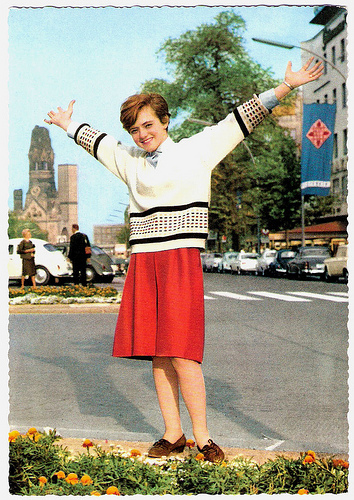
German postcard by Krüger, no. 902/380. Photo: Teldec / Winkler / RCA.
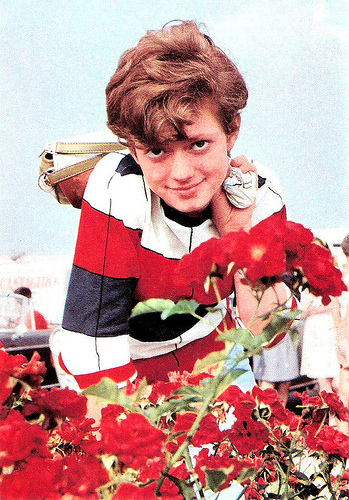
Italian postcard. Photo: RCA.
New Teen Sounds
Rita Pavone was born Turin, Italy in 1945. Mark Deming at AllMusic : “Her father, who worked at a Fiat auto plant, was a big fan of American musical stars, particularly Al Jolson, Judy Garland, and Gene Kelly, and young Rita shared his tastes, often singing along with his records and taking singing lessons when she wasn't busy with school or her part-time job ironing shirts. In 1959, Rita made her public debut as a singer, impersonating Al Jolson in a children's talent contest; by this time, rock & roll had made its way to the continent, and she became an immediate fan of the new teenage sounds. In 1960, Pavone landed her first professional gig, performing for soldiers at Italian NATO bases, and after initial attempts to score a record deal or nightclub engagement proved fruitless, Pavone got her big break in the fall of 1962." She participated in the first Festa degli Sconosciuti (Festival of the Unknowns), a song competition for amateur artists. She won the contest, which was organised by singer and record producer Teddy Reno. The two fell in love. Rita was 17 and Teddy was 19 years her senior and already married, and father of a baby boy. However, they would always stay together. Her first single La partita di pallone (The Ball Game) was an immediate smash. It sold over one million copies, and was awarded a gold disc. Her album debut, simply titled Rita Pavone, made her a national star, and international attention soon followed. Her recording of Cuore (Heart) also sold a million copies in 1963, spending nine weeks at number one in Italy. In the summer of 1964 she had chart success in the United States with Remember Me, backed with Just Once More. Pavone sang at Carnegie Hall in New York city, and between 1964 and 1970, she was a frequent guest at the Ed Sullivan Show, the most popular variety show on American television. Pavone was also very successful in Europe. In the UK, RCA Victor issued two of her singles in quick succession in 1966 and 1967. Both were hits, Heart peaking at #27 and You Only You peaking at #21 in the UK Singles Chart. During this same period she appeared at the London Palladium. Spain would prove to be one of her biggest markets. In this country she scored a string of hits, both with ballads and rock songs and became a teen idol. Pavone recorded a total of thirteen albums. She mainly recorded for RCA until 1968, then she signed for a brief period with Ricordi which launched her vanity label, RitaLand. Eventually she returned to the label that had launched her, recording three more albums with RCA.
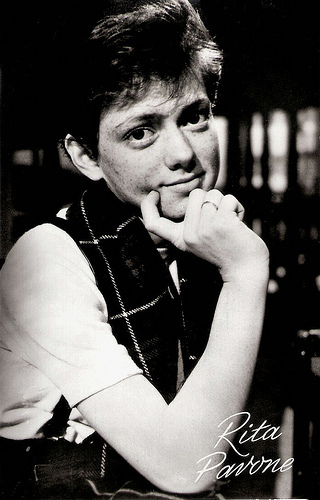
Dutch postcard by Muziek Parade, Hilversum, no. 6137.
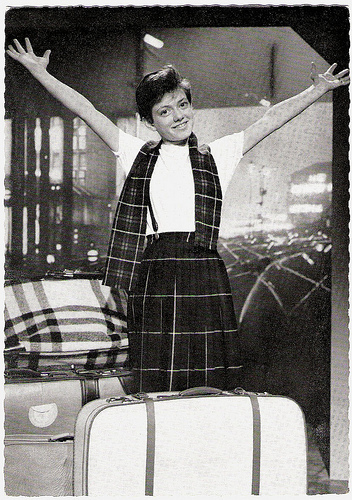
German postcard by Filmbilder-Vertrieb Ernst Freihoff, Essen, no. 840. Retail price: 10 Pfg. Photo: Lothar Winkler.
Musicarellos
In Italy, Rita Pavone also worked as an actress, and during the 1960’s, she starred in six films. The first was the French comedy Clémentine Chérie (Pierre Chevalier, 1963), featuring France Anglade. The others were the Musicarellos (Italian teen musicals of 1950s and 1960s) Rita, la figlia Americana/Rita, the American daughter (Piero Vivarelli, 1965) with Totò, Rita la zanzara/Rita the Mosquito (Lina Wertmüller, 1966) with Giancarlo Giannini, Non stuzzicate la zanzara/Don't Sting the Mosquito (Lina Wertmüller, 1967) with Giulietta Masina as Rita’s mother, the musical Western Little Rita nel west/Rita of the West (Ferdinando Baldi, 1967) with Terence Hill, and La Feldmarescialla/The Crazy Kids of the War (Steno, 1968). In the two Zanzara films, directed by Lina Werthmüller, ´Little Rita´ played a music student in love with her professor, who unknown to her is living a double life as a rock & roll singer. With Werthmüller she also made Giornalino di Gianburrasca/Gian Burrasca's Diary (1964-1965). For this TV series, she also contributed several songs. Pavone’s film career targeted a teen audience and lacked great artistic value, but today her films are cult favourites in Italy. In 1968 Pavone finally married Teddy Reno in a church in Lugano, Switzerland. This event caused a scandal because Reno was still married to his first wife, Livia Protti, and in Italy there was no divorce law until 1970. They re-married each other in Italy in 1971. Later on she would participate in comedy films, such as 2 sul pianerottolo/Two on the landing (Mario Amendola, 1975). On TV, she participated in shows such as Alta Pressione (High Pressure) (1967), Stasera Rita (Tonight Rita) and the variety series Studio Uno (1968). In 1982, she appeared in Come Alice (Like Alice), which became a hit in Italian television. In the theatre, she played Maria in a celebrated production of William Shakespeare's Twelfth Night. And her songs are on many film soundtracks. The main character in the Argentine film Nueve reinas/Nine Queens (Fabián Bielinsky, 2000) tries to remember a Pavone song throughout the film. The song Il Ballo Del Mattone (The Fool's Dance) plays as the credits run. In 2006, she announced her official retirement from show business. She was a Senate candidate in the Italian general election of 2006, for the centre-right list Per l'Italia nel Mondo (For Italy in the World) led by minister Mirko Tremaglia. Rita Pavone and her husband Teddy Reno now live in Ticino, Switzerland. They have two sons, Alessandro and Giorgio, both of whom have become involved in show business themselves, Alessandro as a radio show host and Giorgio as a rock singer.
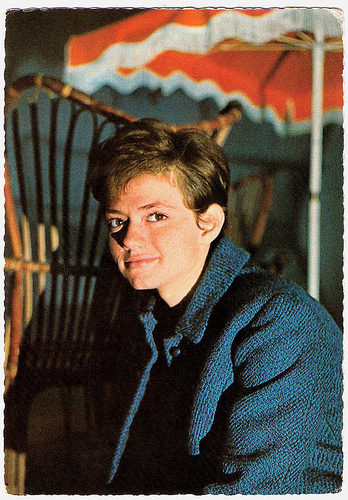
French postcard by E.D.U.G., no. 369. Photo: G. Neuvecelle.
Rita Pavone sings Datemi un Martello (If I Had a Hammer) on a Rai TV Show. Source: Charassita (YouTube).
Rita Pavone sings Il plip in Rita, la figlia Americana/Rita, the American daughter (1965). Source: Paolo Bruzzone (YouTube).
Sources: Mark Deming (AllMusic), Small Wonder (Official Rita Pavone website), Wikipedia and

German postcard by Krüger, no. 902/380. Photo: Teldec / Winkler / RCA.

Italian postcard. Photo: RCA.
New Teen Sounds
Rita Pavone was born Turin, Italy in 1945. Mark Deming at AllMusic : “Her father, who worked at a Fiat auto plant, was a big fan of American musical stars, particularly Al Jolson, Judy Garland, and Gene Kelly, and young Rita shared his tastes, often singing along with his records and taking singing lessons when she wasn't busy with school or her part-time job ironing shirts. In 1959, Rita made her public debut as a singer, impersonating Al Jolson in a children's talent contest; by this time, rock & roll had made its way to the continent, and she became an immediate fan of the new teenage sounds. In 1960, Pavone landed her first professional gig, performing for soldiers at Italian NATO bases, and after initial attempts to score a record deal or nightclub engagement proved fruitless, Pavone got her big break in the fall of 1962." She participated in the first Festa degli Sconosciuti (Festival of the Unknowns), a song competition for amateur artists. She won the contest, which was organised by singer and record producer Teddy Reno. The two fell in love. Rita was 17 and Teddy was 19 years her senior and already married, and father of a baby boy. However, they would always stay together. Her first single La partita di pallone (The Ball Game) was an immediate smash. It sold over one million copies, and was awarded a gold disc. Her album debut, simply titled Rita Pavone, made her a national star, and international attention soon followed. Her recording of Cuore (Heart) also sold a million copies in 1963, spending nine weeks at number one in Italy. In the summer of 1964 she had chart success in the United States with Remember Me, backed with Just Once More. Pavone sang at Carnegie Hall in New York city, and between 1964 and 1970, she was a frequent guest at the Ed Sullivan Show, the most popular variety show on American television. Pavone was also very successful in Europe. In the UK, RCA Victor issued two of her singles in quick succession in 1966 and 1967. Both were hits, Heart peaking at #27 and You Only You peaking at #21 in the UK Singles Chart. During this same period she appeared at the London Palladium. Spain would prove to be one of her biggest markets. In this country she scored a string of hits, both with ballads and rock songs and became a teen idol. Pavone recorded a total of thirteen albums. She mainly recorded for RCA until 1968, then she signed for a brief period with Ricordi which launched her vanity label, RitaLand. Eventually she returned to the label that had launched her, recording three more albums with RCA.

Dutch postcard by Muziek Parade, Hilversum, no. 6137.

German postcard by Filmbilder-Vertrieb Ernst Freihoff, Essen, no. 840. Retail price: 10 Pfg. Photo: Lothar Winkler.
Musicarellos
In Italy, Rita Pavone also worked as an actress, and during the 1960’s, she starred in six films. The first was the French comedy Clémentine Chérie (Pierre Chevalier, 1963), featuring France Anglade. The others were the Musicarellos (Italian teen musicals of 1950s and 1960s) Rita, la figlia Americana/Rita, the American daughter (Piero Vivarelli, 1965) with Totò, Rita la zanzara/Rita the Mosquito (Lina Wertmüller, 1966) with Giancarlo Giannini, Non stuzzicate la zanzara/Don't Sting the Mosquito (Lina Wertmüller, 1967) with Giulietta Masina as Rita’s mother, the musical Western Little Rita nel west/Rita of the West (Ferdinando Baldi, 1967) with Terence Hill, and La Feldmarescialla/The Crazy Kids of the War (Steno, 1968). In the two Zanzara films, directed by Lina Werthmüller, ´Little Rita´ played a music student in love with her professor, who unknown to her is living a double life as a rock & roll singer. With Werthmüller she also made Giornalino di Gianburrasca/Gian Burrasca's Diary (1964-1965). For this TV series, she also contributed several songs. Pavone’s film career targeted a teen audience and lacked great artistic value, but today her films are cult favourites in Italy. In 1968 Pavone finally married Teddy Reno in a church in Lugano, Switzerland. This event caused a scandal because Reno was still married to his first wife, Livia Protti, and in Italy there was no divorce law until 1970. They re-married each other in Italy in 1971. Later on she would participate in comedy films, such as 2 sul pianerottolo/Two on the landing (Mario Amendola, 1975). On TV, she participated in shows such as Alta Pressione (High Pressure) (1967), Stasera Rita (Tonight Rita) and the variety series Studio Uno (1968). In 1982, she appeared in Come Alice (Like Alice), which became a hit in Italian television. In the theatre, she played Maria in a celebrated production of William Shakespeare's Twelfth Night. And her songs are on many film soundtracks. The main character in the Argentine film Nueve reinas/Nine Queens (Fabián Bielinsky, 2000) tries to remember a Pavone song throughout the film. The song Il Ballo Del Mattone (The Fool's Dance) plays as the credits run. In 2006, she announced her official retirement from show business. She was a Senate candidate in the Italian general election of 2006, for the centre-right list Per l'Italia nel Mondo (For Italy in the World) led by minister Mirko Tremaglia. Rita Pavone and her husband Teddy Reno now live in Ticino, Switzerland. They have two sons, Alessandro and Giorgio, both of whom have become involved in show business themselves, Alessandro as a radio show host and Giorgio as a rock singer.

French postcard by E.D.U.G., no. 369. Photo: G. Neuvecelle.
Rita Pavone sings Datemi un Martello (If I Had a Hammer) on a Rai TV Show. Source: Charassita (YouTube).
Rita Pavone sings Il plip in Rita, la figlia Americana/Rita, the American daughter (1965). Source: Paolo Bruzzone (YouTube).
Sources: Mark Deming (AllMusic), Small Wonder (Official Rita Pavone website), Wikipedia and
Published on August 04, 2013 23:00
August 3, 2013
Camillo De Riso
Camillo De Riso (1854-1924) was an Italian actor and director of the Italian stage and silent screen. He was famous for his comic acting and directing at the film companies Ambrosio, Gloria and Caesar.
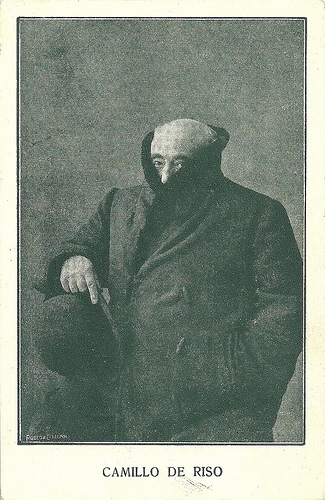
Italian postcard by Magazine Film - Corriere dei cinematografici, Napoli/Roma. Photo: L. Roseo & Co, Naples / Caesar Film.
Fin de Siècle Pochades
Camillo De Riso was born in Naples in 1854. He was the son of Alfonso De Riso, a stage actor who was most popular in the 19th century. Camillo started in the theatre company of his father in the early years of the 20th century, after which he created his own company together with Giuseppe Sichel and Giuseppe Brignone. In 1912 he was hired by Ambrosio Film in Turin, where he formed a successful trio with Gigetta Morano and Eleuterio Rodolfi, contributing with his rotund face, small size and generous look of bourgeois bonhomme. Examples are Un successo diplomatico and L’oca alla Colbert, both 1913 and both directed by Rodolfi. The films of the trio were often based on Italian and French fin de siecle pochades and grew in length over the years. In late 1913, De Riso started at the Gloria company. Here he created the gay epicure and shameless libertine character of ‘Camillo’, and directed himself in a series of comical shorts between 1913 and 1914. He also performed in feature films, a.o. as the theatre impresario Schaudard in Lyda Borelli’s debut film Ma l’amor mio non muore/Love Everlasting (Mario Caserini, 1913), and as the infortunate Giuliano Barbet in Florette e Patapon (Mario Caserini, 1913), an adaptation of the famous pochade by Maurice Hennequin and Pierre Véber. While De Riso also acted in epics and thrillers such as Caserini’s films Nerone e Agrippina/Nero and Agrippina (Mario Caserini, 1913) and Il treno degli spettri/The ghost train (Mario Caserini, 1913) starring Mario Bonnard, he more and more specialised in comedy. As the comedian, he played either the lead in comedies or the sidekick in dramas. At Gloria he was also director, starting with the comedies Somnambulismo/Sleepwalking (1913) and Romanticismo/Romance (1913), and stayed there until 1915. In 1914, De Riso shortly worked for the small Rome based company Latium Film, where he a.o. directed and acted in an adaptation of Émile Zola’s Nana (1914).
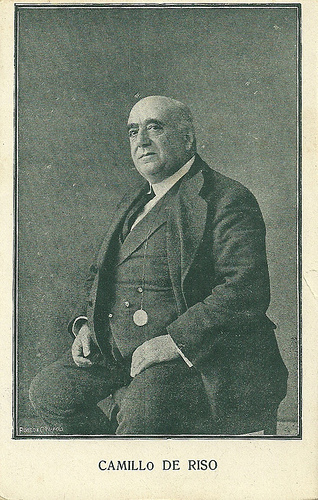
Italian postcard by Magazine Film - Corriere dei cinematografici, Napoli/Roma. Photo: L. Roseo & Co, Naples / Caesar Film.
A New Turn
From 1915 on, Camillo De Riso’s career took a new turn, when he started working at the Roman Caesar Film company. Here he continued his Camillo comedies, well into the early 1920s. He also acted in a long series of films with diva Francesca Bertini. At Caesar, Bertini had a quite fixed cast around her, including De Riso, Gustavo Serena, Olga and Carlo Benetti, Alfredo De Antoni, and Giuseppe De Liguoro. The men of this group often also functioned as director as well, including De Riso. Titles include: La signora delle camelie/Lady of the Camellias (Gustavo Serena, 1915), La perla del cinema/The Cinema Star (Giuseppe De Liguoro, 1916), Baby l'indiavolata/My little baby (Giuseppe De Liguoro, 1916), Odette (Giuseppe De Liguoro, 1916), Andreina (Gustavo Serena, 1917), the series of I sette peccati capitali/The Seven Moral Sins (several directors, 1918-1919) for which De Riso directed the episode La gola/The throat (1918), Mariute (Edoardo Bencivenga, 1918), and Spiritismo/Spiritism (Camillo De Riso, 1919). De Riso also directed other popular actresses of the late 1910s such as Leda Gys (La principessa/The Princess, 1917, which he also scripted), Tilde Kassay (Niniche, 1918; I nostri buoni villici/Our good villagers, 1918; La figlia unica/The only child, 1919; Una donna funesta/Nanà, 1919), and Elena Lunda (Una donna, una mummia, un diplomatico/A woman, a mummy, a diplomat, 1920), but in the early 1920s De Riso mostly directed his own Camillo comical shorts, and he even did a parody of William Shakespeare’s Otello in 1920, which the press didn’t like. Memorable parts De Riso played in A San Francisco (Gustavo Serena, 1915), Don Giovanni (Edoardo Bencivenga, 1916), the Victorien Sardou adaptation Ferréol (Edoardo Bencivenga, 1916), and lastly, in Occupati d’Amelia/Occupied by Amelia (Telemaco Ruggeri, 1923), an adaptation of a famous Georges Feydeau boulevard comedy, starring Pina Menichelli and Marcel Levesque. Camillo De Riso contributed to over a 100 films, mostly comedies, and directed some 65 films, until his premature death in Rome in 1924.
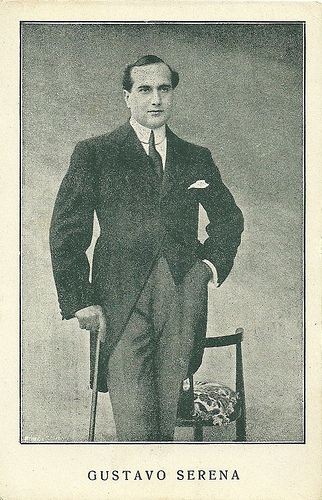
Italian postcard by by the Magazine Film, Naples/Rome. Photo: Caesar Film.
Sources: Encyclopedia of Early Cinema, Wikipedia (Italian), and

Italian postcard by Magazine Film - Corriere dei cinematografici, Napoli/Roma. Photo: L. Roseo & Co, Naples / Caesar Film.
Fin de Siècle Pochades
Camillo De Riso was born in Naples in 1854. He was the son of Alfonso De Riso, a stage actor who was most popular in the 19th century. Camillo started in the theatre company of his father in the early years of the 20th century, after which he created his own company together with Giuseppe Sichel and Giuseppe Brignone. In 1912 he was hired by Ambrosio Film in Turin, where he formed a successful trio with Gigetta Morano and Eleuterio Rodolfi, contributing with his rotund face, small size and generous look of bourgeois bonhomme. Examples are Un successo diplomatico and L’oca alla Colbert, both 1913 and both directed by Rodolfi. The films of the trio were often based on Italian and French fin de siecle pochades and grew in length over the years. In late 1913, De Riso started at the Gloria company. Here he created the gay epicure and shameless libertine character of ‘Camillo’, and directed himself in a series of comical shorts between 1913 and 1914. He also performed in feature films, a.o. as the theatre impresario Schaudard in Lyda Borelli’s debut film Ma l’amor mio non muore/Love Everlasting (Mario Caserini, 1913), and as the infortunate Giuliano Barbet in Florette e Patapon (Mario Caserini, 1913), an adaptation of the famous pochade by Maurice Hennequin and Pierre Véber. While De Riso also acted in epics and thrillers such as Caserini’s films Nerone e Agrippina/Nero and Agrippina (Mario Caserini, 1913) and Il treno degli spettri/The ghost train (Mario Caserini, 1913) starring Mario Bonnard, he more and more specialised in comedy. As the comedian, he played either the lead in comedies or the sidekick in dramas. At Gloria he was also director, starting with the comedies Somnambulismo/Sleepwalking (1913) and Romanticismo/Romance (1913), and stayed there until 1915. In 1914, De Riso shortly worked for the small Rome based company Latium Film, where he a.o. directed and acted in an adaptation of Émile Zola’s Nana (1914).

Italian postcard by Magazine Film - Corriere dei cinematografici, Napoli/Roma. Photo: L. Roseo & Co, Naples / Caesar Film.
A New Turn
From 1915 on, Camillo De Riso’s career took a new turn, when he started working at the Roman Caesar Film company. Here he continued his Camillo comedies, well into the early 1920s. He also acted in a long series of films with diva Francesca Bertini. At Caesar, Bertini had a quite fixed cast around her, including De Riso, Gustavo Serena, Olga and Carlo Benetti, Alfredo De Antoni, and Giuseppe De Liguoro. The men of this group often also functioned as director as well, including De Riso. Titles include: La signora delle camelie/Lady of the Camellias (Gustavo Serena, 1915), La perla del cinema/The Cinema Star (Giuseppe De Liguoro, 1916), Baby l'indiavolata/My little baby (Giuseppe De Liguoro, 1916), Odette (Giuseppe De Liguoro, 1916), Andreina (Gustavo Serena, 1917), the series of I sette peccati capitali/The Seven Moral Sins (several directors, 1918-1919) for which De Riso directed the episode La gola/The throat (1918), Mariute (Edoardo Bencivenga, 1918), and Spiritismo/Spiritism (Camillo De Riso, 1919). De Riso also directed other popular actresses of the late 1910s such as Leda Gys (La principessa/The Princess, 1917, which he also scripted), Tilde Kassay (Niniche, 1918; I nostri buoni villici/Our good villagers, 1918; La figlia unica/The only child, 1919; Una donna funesta/Nanà, 1919), and Elena Lunda (Una donna, una mummia, un diplomatico/A woman, a mummy, a diplomat, 1920), but in the early 1920s De Riso mostly directed his own Camillo comical shorts, and he even did a parody of William Shakespeare’s Otello in 1920, which the press didn’t like. Memorable parts De Riso played in A San Francisco (Gustavo Serena, 1915), Don Giovanni (Edoardo Bencivenga, 1916), the Victorien Sardou adaptation Ferréol (Edoardo Bencivenga, 1916), and lastly, in Occupati d’Amelia/Occupied by Amelia (Telemaco Ruggeri, 1923), an adaptation of a famous Georges Feydeau boulevard comedy, starring Pina Menichelli and Marcel Levesque. Camillo De Riso contributed to over a 100 films, mostly comedies, and directed some 65 films, until his premature death in Rome in 1924.

Italian postcard by by the Magazine Film, Naples/Rome. Photo: Caesar Film.
Sources: Encyclopedia of Early Cinema, Wikipedia (Italian), and
Published on August 03, 2013 23:00
August 2, 2013
Edith Jéhanne
French actress Edith Jéhanne (1902-?) is known for two classic silent films, Le Joueur d'échecs/The Chess player (Raymond Bernard, 1927) and Die Liebe der Jeanne Ney/The Love of Jeanne Ney (Georg Wilhelm Pabst, 1927). After that, she would make only three more films. What finished her promising film career?
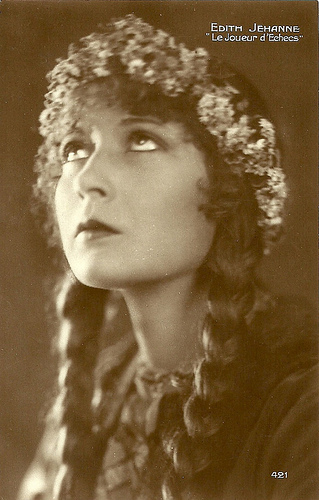
French postcard by Editions Cinémagazine, no. 421. Photo: publicity still for Le joueur d'échecs/The Chess Player (1927).
Tormented by the Political Upheavals
There's not much information on Edith Jéhanne at the net. IMDb mentions as her birth date 1902 and that she was a sister of Sylvia Grey, who also appeared in a few silent films. When or where Jéhanne died is not known, nor whether she was related to director Raymond Bernard with whom she made most of her films. She debuted in his sentimental comedy Triplepatte/Toddles (Raymond Bernard, 1922) based on a play by Bernard's father, Tristan Bernard. Next she performed in the adventure serial Rouletabille chez les bohemiens/Rouletabille Among the Bohemians (Henri Fescourt, 1923), opposite Gabriel de Gravone, Romuald Joubé and Joë Hamman. The following year she had a small part in Bernard's historical drama Le miracle des loups/Miracle of the Wolves (Raymond Bernard, 1924), an epic film about he struggle between Louis XI and Charles le Téméraire. 1927 was her peak year. Jéhanne got the lead in two major films. First in the Ufa production Die Liebe der Jeanne Ney/The Love Of Jeanne Ney (Georg Wilhelm Pabst, 1927), based on a story by Ilya Ehrenburg. Jéhanne plays Jeanne Ney, a woman tormented by the political upheavals of the period following the First World War. When the Red Army occupies Crimea, Jeanne's father, a French journalist, is killed. Jeanne's lover, the Bolshevik Andreas ( Uno Henning ), sends Jeanne to her family in Paris but he is preceded by the counterrevolutionary Khalibiev (Fritz Rasp), who murders Jeanne's uncle. Andreas is accused of the murder and Khalibiev proposes to marry Jeanne's blind cousin (Brigitte Helm). Director Pabst mixed here successfully a straight forward American film style with echoes of the Soviet montage style and German expressionism.
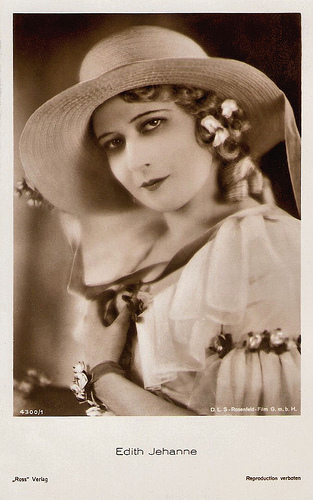
German postcard by Ross Verlag, no. 4300/1, 1929-1930. Photo: D.L.S. / Rosenfeld-Film G.m.b.H.
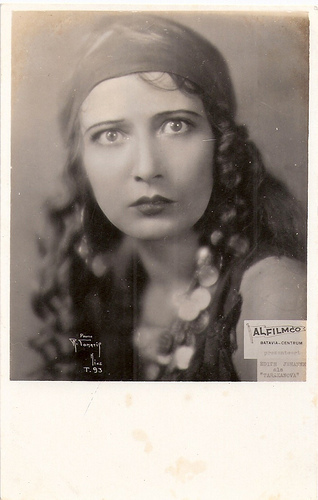
Dutch postcard for the Al Film Co., Batavia-Centrum (former Dutch East Indies, now Indonesia), no. T. 93. Photo: R. Tomarig, Nice. Publicity still for Tarakanova (Raymond Bernard, 1930). This picture was also used for posters and magazine covers.
Grand Spectacle
Then, Edith Jehanne and Pierre Blanchar played the leads in Le joueur d'échecs/The Chess Player (Raymond Bernard, 1927), about 19th century Poland striving for independence. Polish freedom fighter Boleslas loves Sophie, while they are both active in the independence movement. She becomes attracted to Oblonoff, a young officer in charge of the Russian forces in Poland. When Boleslas is wounded during an insurrection at Vilmo, Sophie stays at his side. He is hidden in a chess-player mannequin that ends up at the court of the Russian Czarina Catherine II. He plays against her... The film was grand spectacle, using 35 decors including an enormous set for the Winter Palace. Hal Erickson describes at AllMovie the highlight of the film: "The film's dramatic highlight was one of the most astonishing sequences in all of French cinema: On the verge of madness because her beloved Polish army is being mercilessly slaughtered by the Russians, the heroine sits down at her piano and begins playing maniacally - whereupon she hallucinates that the Poles have won the battle and are marching homeward in triumph." However, after these major works, Edith Jéhanne only made three more films. In two she had the female lead: the psychological drama Le perroquet vert/The Green Parrot (Jean Milva, 1928) with Max Maxudian, and the late silent production Tarakanova (Raymond Bernard, 1930) with Olaf Fjord and Rudolf Klein-Rogge. In this film, she played an impostor who claims to be the heir to the Russian throne. When the Czarina (Paule Andral) sends her best aid to capture the girl, he falls in love with her. It was Bernard's last silent film, shot in 1929, but held back to add a soundtrack in 1930. Bernard considered it his best film, but no copy of the film ever showed up so we can't judge for ourselves. After that, Jéhanne only had a minor part in the early sound film Quand nous étions deux/When We Were Two (Léonce Perret, 1929), starring Alice Roberts and André Roanne. And then her promising film career stopped. Was the advent of sound film the reason? IMDb gives another explanation: "Raymond Bernard remembered Edith Jehanne died soon after the coming of the Talkies." But when, where, how?
The highlight scene from Le joueur d'échecs (1927). Source: Skazibus (YouTube).
Sources: Hal Erickson (AllMovie), Filmportal.de and

French postcard by Editions Cinémagazine, no. 421. Photo: publicity still for Le joueur d'échecs/The Chess Player (1927).
Tormented by the Political Upheavals
There's not much information on Edith Jéhanne at the net. IMDb mentions as her birth date 1902 and that she was a sister of Sylvia Grey, who also appeared in a few silent films. When or where Jéhanne died is not known, nor whether she was related to director Raymond Bernard with whom she made most of her films. She debuted in his sentimental comedy Triplepatte/Toddles (Raymond Bernard, 1922) based on a play by Bernard's father, Tristan Bernard. Next she performed in the adventure serial Rouletabille chez les bohemiens/Rouletabille Among the Bohemians (Henri Fescourt, 1923), opposite Gabriel de Gravone, Romuald Joubé and Joë Hamman. The following year she had a small part in Bernard's historical drama Le miracle des loups/Miracle of the Wolves (Raymond Bernard, 1924), an epic film about he struggle between Louis XI and Charles le Téméraire. 1927 was her peak year. Jéhanne got the lead in two major films. First in the Ufa production Die Liebe der Jeanne Ney/The Love Of Jeanne Ney (Georg Wilhelm Pabst, 1927), based on a story by Ilya Ehrenburg. Jéhanne plays Jeanne Ney, a woman tormented by the political upheavals of the period following the First World War. When the Red Army occupies Crimea, Jeanne's father, a French journalist, is killed. Jeanne's lover, the Bolshevik Andreas ( Uno Henning ), sends Jeanne to her family in Paris but he is preceded by the counterrevolutionary Khalibiev (Fritz Rasp), who murders Jeanne's uncle. Andreas is accused of the murder and Khalibiev proposes to marry Jeanne's blind cousin (Brigitte Helm). Director Pabst mixed here successfully a straight forward American film style with echoes of the Soviet montage style and German expressionism.

German postcard by Ross Verlag, no. 4300/1, 1929-1930. Photo: D.L.S. / Rosenfeld-Film G.m.b.H.

Dutch postcard for the Al Film Co., Batavia-Centrum (former Dutch East Indies, now Indonesia), no. T. 93. Photo: R. Tomarig, Nice. Publicity still for Tarakanova (Raymond Bernard, 1930). This picture was also used for posters and magazine covers.
Grand Spectacle
Then, Edith Jehanne and Pierre Blanchar played the leads in Le joueur d'échecs/The Chess Player (Raymond Bernard, 1927), about 19th century Poland striving for independence. Polish freedom fighter Boleslas loves Sophie, while they are both active in the independence movement. She becomes attracted to Oblonoff, a young officer in charge of the Russian forces in Poland. When Boleslas is wounded during an insurrection at Vilmo, Sophie stays at his side. He is hidden in a chess-player mannequin that ends up at the court of the Russian Czarina Catherine II. He plays against her... The film was grand spectacle, using 35 decors including an enormous set for the Winter Palace. Hal Erickson describes at AllMovie the highlight of the film: "The film's dramatic highlight was one of the most astonishing sequences in all of French cinema: On the verge of madness because her beloved Polish army is being mercilessly slaughtered by the Russians, the heroine sits down at her piano and begins playing maniacally - whereupon she hallucinates that the Poles have won the battle and are marching homeward in triumph." However, after these major works, Edith Jéhanne only made three more films. In two she had the female lead: the psychological drama Le perroquet vert/The Green Parrot (Jean Milva, 1928) with Max Maxudian, and the late silent production Tarakanova (Raymond Bernard, 1930) with Olaf Fjord and Rudolf Klein-Rogge. In this film, she played an impostor who claims to be the heir to the Russian throne. When the Czarina (Paule Andral) sends her best aid to capture the girl, he falls in love with her. It was Bernard's last silent film, shot in 1929, but held back to add a soundtrack in 1930. Bernard considered it his best film, but no copy of the film ever showed up so we can't judge for ourselves. After that, Jéhanne only had a minor part in the early sound film Quand nous étions deux/When We Were Two (Léonce Perret, 1929), starring Alice Roberts and André Roanne. And then her promising film career stopped. Was the advent of sound film the reason? IMDb gives another explanation: "Raymond Bernard remembered Edith Jehanne died soon after the coming of the Talkies." But when, where, how?
The highlight scene from Le joueur d'échecs (1927). Source: Skazibus (YouTube).
Sources: Hal Erickson (AllMovie), Filmportal.de and
Published on August 02, 2013 23:00
August 1, 2013
Tina Aumont
Although lovely and tragic Tina Aumont (1946–2006) was born in Hollywood, she mostly filmed in her country of adoption, Italy. With her dark and soulful eyes she became a flamboyant, rebellious star of the Italian cinema in the 1960s and 1970s. Her remarkable career took a downturn, when she was banned from Italy for drug possession. During her career, Aumont starred in more than forty films, ranging from international big productions and Italian films by directors like Federico Fellini and Bernardo Bertolucci, to French art films and underground cinema.
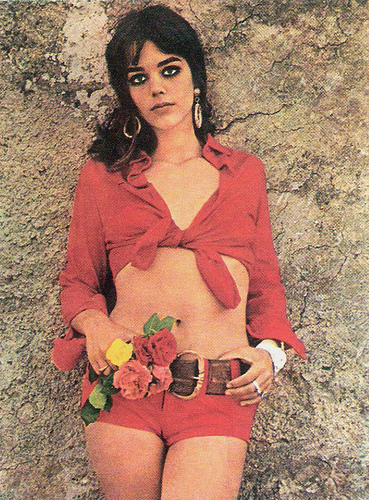
Yugoslavian postcard by Cik Razglednica.
The Summer Of '68
Maria Christina Aumont was born in Hollywood, US, in 1946. She was the daughter of French Jewish actor Jean-Pierre Aumont and Dominican actress Maria Montez, who were both Hollywood stars at the time. Jean Cocteau wrote a poem for her birth ‘La Fille aux étoiles’ and Marlene Dietrich sang lullabies while cradling her. Her mother died when Tina was only 5. Later she said about her mother in an interview: “I regret not to remember her clearly, because I was too little when she died. Even though I have a living mental image of her, which I attribute to, while years were passing, her remembrance was always close to me through the conversations with my father, my aunts, my uncle François, well, from my whole family.” During her teen years and the first years of her youth, Tina lived simultaneously with her paternal uncle and his wife and with her father, who made a new home. Five years after Maria Montez death, Jean-Pierre got married again with the Italian actress Marisa Pavan, twin-sister of Pier Angeli. The relationship between Tina and Marisa wasn't good. In 1963, the 17-years-old Tina married actor and film director Christian Marquand, a friend of her father. She made her debut as Tina Marquand in the spy spoof Modesty Blaise (Joseph Losey, 1966) starring Monica Vitti. In France she also made La Curée/The Game is Over (Roger Vadim, 1966) starring Jane Fonda. In Italy, she appeared in the comedy Scusi, lei è favorevole o contrario?/Pardon, Are You for or Against? (Alberto Sordi, 1966). In Hollywood, she played Lonetta, the Indian maiden, opposite Dean Martin and Alain Delon in the comic Western Texas Across the River (Michael Gordon, 1967). Aumont divorced Christian Marquand in 1967, and a year later, she met artist and painter Frederic Pardo. They fell in love and went to live together in Rome. They separated in the 1970s. In Rome, she appeared in Bernardo Bertolucci’s Il sosia/Partner (1968) with Pierre Clémenti. Hal Erickson at AllMovie : “Bernardo Bertolucci was obviously influenced by the films of Jean-Luc Godard and the worldwide political upheavals of 1968 while assembling his feature-film Partner. This unorthodox adaptation of Dostoevsky's The Double studiously avoids traditional linear storytelling and exposition techniques.” She played Circe in Satyricon/The Degenerates (1969), not the masterpiece directed by Federico Fellini, but a version by Gian Luigi Polidoro. Polidoro registered the title Satyricon for his film first. Fellini fought to use the title for his film but lost the case. He named his film Fellini – Satyricon (1969). Aumont also appeared in Infanzia, vocazione e prime esperienze di Giacomo Casanova Veneziano/Giacomo Casanova: Childhood And Adolescence (Luigi Comencini, 1969) with Leonard Whiting as Casanova, the avant-garde underground film Necropolis (Franco Brocani, 1970), and the political drama Metello (Mauro Bolognini, 1970). In France she played in the art film La lit de la vierge/The Virgin's Bed (Philippe Garrel, 1969). Nathan Southern at AllMovie : “Garrel and his cast and crew shot La lit in the summer of '68 (reportedly under the influence of acid and without a script), just a few months after the bouleversement of the riots. In that picture, the filmmakers adapt the Biblical story of Jesus very loosely and non-narratively, using Christ as a metaphoric symbol of the late '60s protest movement - the ‘ultimate hippie.’ The picture also reflects the filmmakers' self-mythologies of existing and functioning as a ‘religious sect.’”
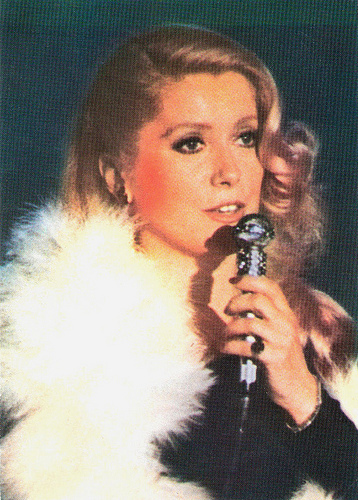
Catherine Deneuve. Romanian postcard by Casa Filmului Acin.
343 Notorious Women
Tina Aumont played her first lead role in L'Urlo/The Howl (Tinto Brass, 1970) in which Brass explored the changing mood of the Swinging Sixties. Tina played a student activist whose politics move even further to the left after she's raped by police officers. In 1971 Aumont made headlines, when she and other ‘notorious women’ signed the Manifeste des 343 salopes in favor of the decriminalization of abortion. The 343 women who signed the manifesto claimed to have an abortion and that, consequently, they risked criminal prosecution that could reach the imprisonment. During the 1970s, Aumont starred in some prolific Italian productions like the courtroom drama Fatti di gente perbene/The Murri Affair (Mauro Bolognini, 1974) with Catherine Deneuve, the political thriller Cadaveri eccellenti/Illustrious Corpses (Francesco Rosi, 1975), and the scandalous success Salon Kitty (Tinto Brass, 1975), a shocking but stylish tale of decadence in the Third Reich, inspired by a true story. Brass later said she was the most beautiful woman with whom he'd ever worked. She also worked with Federico Fellini at Il Casanova di Fellini/Fellini's Casanova (1976) featuring Donald Sutherland as the famous lover, and with Roberto Rossellini at Il messia/The Messiah (1975). Besides these prestigious productions, she also starred in many genre films. Examples are the Spaghetti Western L'uomo, l'orgoglio, la vendetta/ Man: His Pride and His Vengeance (Luigi Bazzoni, 1968) starring Franco Nero, and the Giallo I corpi presentano tracce di violenza carnale/Torso (Sergio Martino,1973). She appeared in the Italian-American production A Matter of Time/Nina (Vincente Minnelli, 1976) with Liza Minnelli and Ingrid Bergman. Tina's flamboyant career took a downturn in the late 1970s, when she was banned from Italy for drug possession. Gio Clairval at her blog Kosmochlor: “To all her films, she brought her magnetic, compelling presence. But Tina loved the needle, and little by little her contracts dwindled to nothing. The French television tried to lure her back into acting, but she seldom kept up with the schedule, and when the dressers prepared her for a scene, they could see the needle holes constellating her arms.” In the cinema she appeared in the experimental silent film Rebelote (Jacques Richard, 1983) with Jean-Pierre Léaud. Her scenes in Sale comme un ange/Dirty Like an Angel (Catherine Breillat, 1991) were deleted. In 2000 she retired from film work, because she suffered a pulmonary embolism. Her final film appearance was in La mécanique des femmes/ The Mechanics of Women (Jérôme de Missolz, 2000) In 2006, Tina Aumont died in of a respiratory insufficiency in her home in Port-Vendres, France. She was 60. She is buried in Montparnasse Cemetery, Paris, in the same grave as her mother's.
Trailer Il Casanova di Federico Fellini (1976). Source: Danios12345 ().
Sources: Hal Erickson (AllMovie), Nathan Southern (AllMovie), Gio Clairval (Kosmochlor), Love Luna (Child of the Moon), Vivian Pérez and Luisa Peguero (MariaMontez.org), Anti Star Tina, Wikipedia, and

Yugoslavian postcard by Cik Razglednica.
The Summer Of '68
Maria Christina Aumont was born in Hollywood, US, in 1946. She was the daughter of French Jewish actor Jean-Pierre Aumont and Dominican actress Maria Montez, who were both Hollywood stars at the time. Jean Cocteau wrote a poem for her birth ‘La Fille aux étoiles’ and Marlene Dietrich sang lullabies while cradling her. Her mother died when Tina was only 5. Later she said about her mother in an interview: “I regret not to remember her clearly, because I was too little when she died. Even though I have a living mental image of her, which I attribute to, while years were passing, her remembrance was always close to me through the conversations with my father, my aunts, my uncle François, well, from my whole family.” During her teen years and the first years of her youth, Tina lived simultaneously with her paternal uncle and his wife and with her father, who made a new home. Five years after Maria Montez death, Jean-Pierre got married again with the Italian actress Marisa Pavan, twin-sister of Pier Angeli. The relationship between Tina and Marisa wasn't good. In 1963, the 17-years-old Tina married actor and film director Christian Marquand, a friend of her father. She made her debut as Tina Marquand in the spy spoof Modesty Blaise (Joseph Losey, 1966) starring Monica Vitti. In France she also made La Curée/The Game is Over (Roger Vadim, 1966) starring Jane Fonda. In Italy, she appeared in the comedy Scusi, lei è favorevole o contrario?/Pardon, Are You for or Against? (Alberto Sordi, 1966). In Hollywood, she played Lonetta, the Indian maiden, opposite Dean Martin and Alain Delon in the comic Western Texas Across the River (Michael Gordon, 1967). Aumont divorced Christian Marquand in 1967, and a year later, she met artist and painter Frederic Pardo. They fell in love and went to live together in Rome. They separated in the 1970s. In Rome, she appeared in Bernardo Bertolucci’s Il sosia/Partner (1968) with Pierre Clémenti. Hal Erickson at AllMovie : “Bernardo Bertolucci was obviously influenced by the films of Jean-Luc Godard and the worldwide political upheavals of 1968 while assembling his feature-film Partner. This unorthodox adaptation of Dostoevsky's The Double studiously avoids traditional linear storytelling and exposition techniques.” She played Circe in Satyricon/The Degenerates (1969), not the masterpiece directed by Federico Fellini, but a version by Gian Luigi Polidoro. Polidoro registered the title Satyricon for his film first. Fellini fought to use the title for his film but lost the case. He named his film Fellini – Satyricon (1969). Aumont also appeared in Infanzia, vocazione e prime esperienze di Giacomo Casanova Veneziano/Giacomo Casanova: Childhood And Adolescence (Luigi Comencini, 1969) with Leonard Whiting as Casanova, the avant-garde underground film Necropolis (Franco Brocani, 1970), and the political drama Metello (Mauro Bolognini, 1970). In France she played in the art film La lit de la vierge/The Virgin's Bed (Philippe Garrel, 1969). Nathan Southern at AllMovie : “Garrel and his cast and crew shot La lit in the summer of '68 (reportedly under the influence of acid and without a script), just a few months after the bouleversement of the riots. In that picture, the filmmakers adapt the Biblical story of Jesus very loosely and non-narratively, using Christ as a metaphoric symbol of the late '60s protest movement - the ‘ultimate hippie.’ The picture also reflects the filmmakers' self-mythologies of existing and functioning as a ‘religious sect.’”

Catherine Deneuve. Romanian postcard by Casa Filmului Acin.
343 Notorious Women
Tina Aumont played her first lead role in L'Urlo/The Howl (Tinto Brass, 1970) in which Brass explored the changing mood of the Swinging Sixties. Tina played a student activist whose politics move even further to the left after she's raped by police officers. In 1971 Aumont made headlines, when she and other ‘notorious women’ signed the Manifeste des 343 salopes in favor of the decriminalization of abortion. The 343 women who signed the manifesto claimed to have an abortion and that, consequently, they risked criminal prosecution that could reach the imprisonment. During the 1970s, Aumont starred in some prolific Italian productions like the courtroom drama Fatti di gente perbene/The Murri Affair (Mauro Bolognini, 1974) with Catherine Deneuve, the political thriller Cadaveri eccellenti/Illustrious Corpses (Francesco Rosi, 1975), and the scandalous success Salon Kitty (Tinto Brass, 1975), a shocking but stylish tale of decadence in the Third Reich, inspired by a true story. Brass later said she was the most beautiful woman with whom he'd ever worked. She also worked with Federico Fellini at Il Casanova di Fellini/Fellini's Casanova (1976) featuring Donald Sutherland as the famous lover, and with Roberto Rossellini at Il messia/The Messiah (1975). Besides these prestigious productions, she also starred in many genre films. Examples are the Spaghetti Western L'uomo, l'orgoglio, la vendetta/ Man: His Pride and His Vengeance (Luigi Bazzoni, 1968) starring Franco Nero, and the Giallo I corpi presentano tracce di violenza carnale/Torso (Sergio Martino,1973). She appeared in the Italian-American production A Matter of Time/Nina (Vincente Minnelli, 1976) with Liza Minnelli and Ingrid Bergman. Tina's flamboyant career took a downturn in the late 1970s, when she was banned from Italy for drug possession. Gio Clairval at her blog Kosmochlor: “To all her films, she brought her magnetic, compelling presence. But Tina loved the needle, and little by little her contracts dwindled to nothing. The French television tried to lure her back into acting, but she seldom kept up with the schedule, and when the dressers prepared her for a scene, they could see the needle holes constellating her arms.” In the cinema she appeared in the experimental silent film Rebelote (Jacques Richard, 1983) with Jean-Pierre Léaud. Her scenes in Sale comme un ange/Dirty Like an Angel (Catherine Breillat, 1991) were deleted. In 2000 she retired from film work, because she suffered a pulmonary embolism. Her final film appearance was in La mécanique des femmes/ The Mechanics of Women (Jérôme de Missolz, 2000) In 2006, Tina Aumont died in of a respiratory insufficiency in her home in Port-Vendres, France. She was 60. She is buried in Montparnasse Cemetery, Paris, in the same grave as her mother's.
Trailer Il Casanova di Federico Fellini (1976). Source: Danios12345 ().
Sources: Hal Erickson (AllMovie), Nathan Southern (AllMovie), Gio Clairval (Kosmochlor), Love Luna (Child of the Moon), Vivian Pérez and Luisa Peguero (MariaMontez.org), Anti Star Tina, Wikipedia, and
Published on August 01, 2013 23:00
July 31, 2013
Marisol
Marisol (1948) was a Spanish child star of the 1960s. When she became an adult she stayed a popular actress and singer under her real name, Pepa Flores.
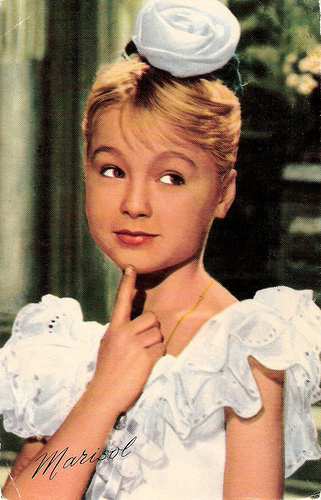
Dutch postcard.
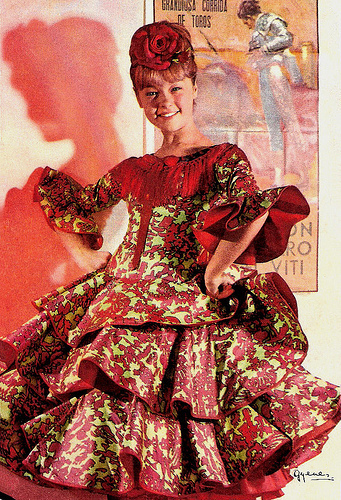
Spanish postcard by Ediciones TarjeFher, no. 112, 1964. Photo: Juan Gyenes / Manuel J. Goyanes.
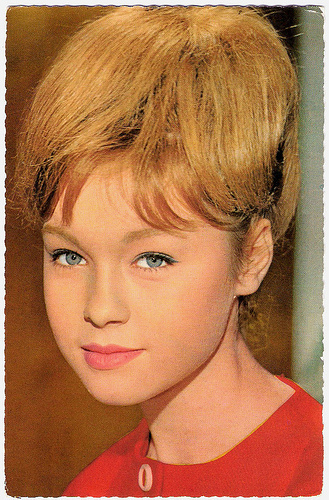
Spanish postcard by Ediciones TarjeFher / Ediciones Mandolina, no. 126, 1964. Photo: Manuel J. Goyanes.
Tómbola
Maria Josefa Flores González was born in Málaga, Spain in 1948. She has an older sister, Victoria, and a younger brother, Enrique. From early on, she demonstrated a great love for singing and traditional flamenco dance. She was discovered by her future producer Manuel J. Goyanes on Spanish Television in the show Coros y Danzas de Málaga/Songs and Dances of Malaga in 1959. Her cinema debut as Marisol was in the musical Un rayo de luz/A Ray of Light (Luis Lucia, 1960). She became an international sensation, from Spain to Japan. She won the Best Child Actress award at the Venice Film Festival in 1960. In the following decade she starred in a dozen musical comedy-dramas. She also made records, did concerts and TV shows. The title song of her third film, Tómbola/Lottery (Luis Lucia, 1962), became a Spanish classic. Other of her film vehicles were Marisol rumbo a Río/Marisol Is Bound For Rio (Fernando Palacios, 1963), a Spanish variation on The Parent Trap with Marisol playing both the poor teenager from Madrid as well as her estranged sister in Rio De Janeiro, and La nueva Cenicienta/The New Cinderella (George Sherman, 1964) with Robert Conrad and Fernando Rey. Mel Ferrer directed her in Cabriola/Everyday Is A Holiday (1965) where she sang one of her most beautiful songs: Cabriola. The child star became a stunning beauty and in 1967 she starred as a grown-up opposite Jean-Claude Pascal in Las 4 bodas de Marisol/The Four Weddings of Marisol (Luis Lucia, 1967) as a film star with man trouble. She continued to make popular films, including Carola de día, Carola de noche/Carola during day and night (Jaime de Armiñán, 1969), a Spanish variation on Roman Holiday about a princess, who secretly goes out by night to find out how Spaniards live. That year she married with Carlos Goyanes, the son of her discoverer.
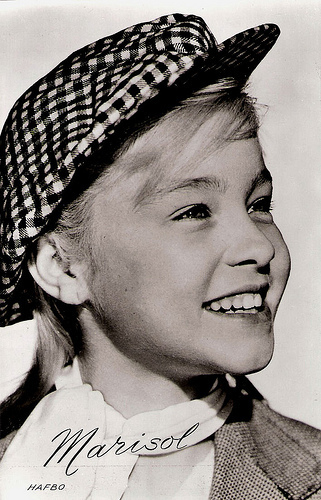
Dutch postcard by Takken, Utrecht, no. 5060. Photo: Hafbo. Publicity still for Ha llegado un angel/An Angel Has Appeared (Luis Lucia, 1961).
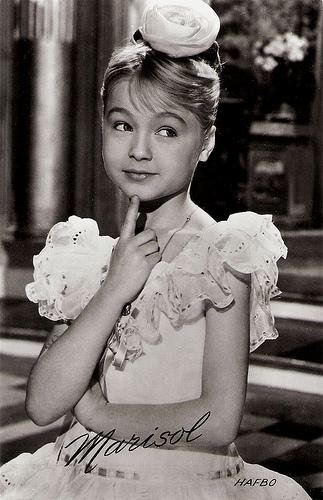
Dutch postcard by Takken, Utrecht, no. 5220. Photo: Hafbo.
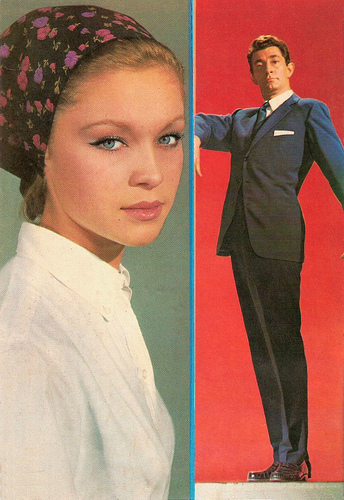
Marisol and Jean-Claude Pascal. Spanish postcard by Postal OscarColor, S.A., Hospitalet (Barcelona), no. 702.
A Living Myth
Marisol started to appear in more serious films. She played the titel character in the thriller La corrupción de Chris Miller/The Corruption of Chris Miller (Juan Antonio Bardem, 1973) opposite Jean Seberg. She also appeared in Bardem's (the uncle of awarded Spanish actor Javier Bardem) El poder del deseo/The Power of Desire (Juan Antonio Bardem, 1975) opposite British actor Murray Head and in Los días del pasado/The Days of the Past (Mario Camus, 1978) with flamenco dancer and choreographer Antonio Gades. She was awarded the Best Actress prize at the Karlovy Vary International Film Festival for her role in the latter film. In 1982 she married Antonio Gades in Cuba. The best man to their wedding was Fidel Castro. She acted with Gades in Bodas de sangre/Blood Wedding (Carlos Saura, 1981) based on Federico García Lorca's revenge play, and Carmen (Carlos Saura, 1983). She worked then under the name Pepa Flores. She appeared in the title role of the Spanish national television series Mariana Pineda in 1984, in which she played a Liberal Party's hero. In 1985, when she was still at the height of her career, she left show business. Her last film was the political film Caso cerrado/Case Closed (Juan Caño Arecha, 1985) with in a small role the young Antonio Banderas. She returned to her homeland, Malaga. She received many invitations to return and requests for TV interviews, but she declined all of them. In 1986 she and Gades divorced. They have three daughters: Maria, Tamara, and Celia. Her daughter Maria Esteve is now a well known actress in Spain, and her youngest daughter, Celia, is a pop flamenco singer. Pepa Flores still lives in Málaga with her partner Máximo Stecchiny and works as a humanitarian activist. Twentyfive years after her retirement, she is 'un mito', a living myth in Spain. Last year she was the subject of a TV miniseries, Marisol (Manuel Palacios, 2009).
Marisol sings Tengo el corazon contento in a 1968 TV show. Source: seductor25 (YouTube).
Tribute to Marisol with Tómbola a.o. Source: producionesgallago (YouTube).
Sources:

Dutch postcard.

Spanish postcard by Ediciones TarjeFher, no. 112, 1964. Photo: Juan Gyenes / Manuel J. Goyanes.

Spanish postcard by Ediciones TarjeFher / Ediciones Mandolina, no. 126, 1964. Photo: Manuel J. Goyanes.
Tómbola
Maria Josefa Flores González was born in Málaga, Spain in 1948. She has an older sister, Victoria, and a younger brother, Enrique. From early on, she demonstrated a great love for singing and traditional flamenco dance. She was discovered by her future producer Manuel J. Goyanes on Spanish Television in the show Coros y Danzas de Málaga/Songs and Dances of Malaga in 1959. Her cinema debut as Marisol was in the musical Un rayo de luz/A Ray of Light (Luis Lucia, 1960). She became an international sensation, from Spain to Japan. She won the Best Child Actress award at the Venice Film Festival in 1960. In the following decade she starred in a dozen musical comedy-dramas. She also made records, did concerts and TV shows. The title song of her third film, Tómbola/Lottery (Luis Lucia, 1962), became a Spanish classic. Other of her film vehicles were Marisol rumbo a Río/Marisol Is Bound For Rio (Fernando Palacios, 1963), a Spanish variation on The Parent Trap with Marisol playing both the poor teenager from Madrid as well as her estranged sister in Rio De Janeiro, and La nueva Cenicienta/The New Cinderella (George Sherman, 1964) with Robert Conrad and Fernando Rey. Mel Ferrer directed her in Cabriola/Everyday Is A Holiday (1965) where she sang one of her most beautiful songs: Cabriola. The child star became a stunning beauty and in 1967 she starred as a grown-up opposite Jean-Claude Pascal in Las 4 bodas de Marisol/The Four Weddings of Marisol (Luis Lucia, 1967) as a film star with man trouble. She continued to make popular films, including Carola de día, Carola de noche/Carola during day and night (Jaime de Armiñán, 1969), a Spanish variation on Roman Holiday about a princess, who secretly goes out by night to find out how Spaniards live. That year she married with Carlos Goyanes, the son of her discoverer.

Dutch postcard by Takken, Utrecht, no. 5060. Photo: Hafbo. Publicity still for Ha llegado un angel/An Angel Has Appeared (Luis Lucia, 1961).

Dutch postcard by Takken, Utrecht, no. 5220. Photo: Hafbo.

Marisol and Jean-Claude Pascal. Spanish postcard by Postal OscarColor, S.A., Hospitalet (Barcelona), no. 702.
A Living Myth
Marisol started to appear in more serious films. She played the titel character in the thriller La corrupción de Chris Miller/The Corruption of Chris Miller (Juan Antonio Bardem, 1973) opposite Jean Seberg. She also appeared in Bardem's (the uncle of awarded Spanish actor Javier Bardem) El poder del deseo/The Power of Desire (Juan Antonio Bardem, 1975) opposite British actor Murray Head and in Los días del pasado/The Days of the Past (Mario Camus, 1978) with flamenco dancer and choreographer Antonio Gades. She was awarded the Best Actress prize at the Karlovy Vary International Film Festival for her role in the latter film. In 1982 she married Antonio Gades in Cuba. The best man to their wedding was Fidel Castro. She acted with Gades in Bodas de sangre/Blood Wedding (Carlos Saura, 1981) based on Federico García Lorca's revenge play, and Carmen (Carlos Saura, 1983). She worked then under the name Pepa Flores. She appeared in the title role of the Spanish national television series Mariana Pineda in 1984, in which she played a Liberal Party's hero. In 1985, when she was still at the height of her career, she left show business. Her last film was the political film Caso cerrado/Case Closed (Juan Caño Arecha, 1985) with in a small role the young Antonio Banderas. She returned to her homeland, Malaga. She received many invitations to return and requests for TV interviews, but she declined all of them. In 1986 she and Gades divorced. They have three daughters: Maria, Tamara, and Celia. Her daughter Maria Esteve is now a well known actress in Spain, and her youngest daughter, Celia, is a pop flamenco singer. Pepa Flores still lives in Málaga with her partner Máximo Stecchiny and works as a humanitarian activist. Twentyfive years after her retirement, she is 'un mito', a living myth in Spain. Last year she was the subject of a TV miniseries, Marisol (Manuel Palacios, 2009).
Marisol sings Tengo el corazon contento in a 1968 TV show. Source: seductor25 (YouTube).
Tribute to Marisol with Tómbola a.o. Source: producionesgallago (YouTube).
Sources:
Published on July 31, 2013 23:00
July 30, 2013
Maria Grazia Buccella
Sexy Italian film Actress Maria Grazia Buccella (1940) was a former glamour model and Miss Italy contestant (1959). She was the busty and a bit dizzy beauty in many Italian comedies of the 1960s and 1970s.
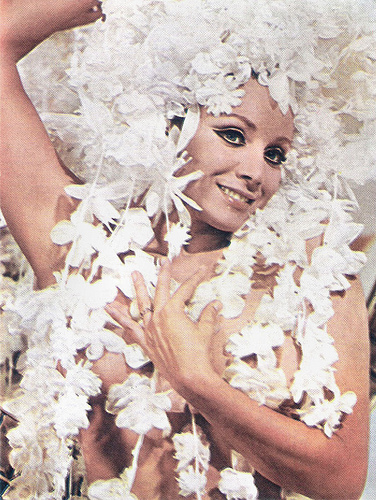
Yugoslavian postcard by Cik Razglednica. Photo: publicity still for Sissignore (Ugo Tognazzi, 1968).
Miss Universe
Maria Grazia Buccella was born in Milan, Italy in 1940. At 11, she made her film debut with a bit role in the French-Italian crime drama Le cap de l'espérance/The Cape of Hope (Raymond Bernard, 1951), starring Edwige Feuillère. At 17 she was chosen as Miss Venezia Tridentina. In 1959, she was one of the contestants of the Miss Italy contest. She represented Italy at the Miss Europe contest, where she came in third, and at the Miss Universe contest. After that she started to play small parts in films again. Her first bigger role was in the comedy Fontana di Trevi/Fountain of Trevi (Carlo Campogalliani, 1960) with Claudio Villa. In the following years, she played big roles in forgettable comedies and a small part in Il boom/The Boom (Vittorio De Sica, 1963) starring Alberto Sordi. Other films were Cover Girls (José Bénazéraf, 1964) with Giorgia Moll, and Menage all'italiana/Menage Italian Style (Franco Indovina, 1965) with Ugo Tognazzi. She screentested for the role of Domino Derval in the James Bond film Thunderball (Terence Young, 1965), but the role eventually went to French actress, Claudine Auger. That year, she appeared in the Italian film Il Gaucho/The Gaucho (Dino Risi, 1965) which co-starred Vittorio Gassman. She appeared with Gassman again in the comedy Una vergine per il principe/A Maiden for a Prince (Pasquale Festa Campanile, 1966) and in the action comedy L'armata Brancaleone/For Love and Gold (Mario Monicelli, 1966). That year, she also played the beauty Miss Okra in the Peter Sellers film Caccia alla volpe/After the Fox (Vittorio De Sica, 1966).
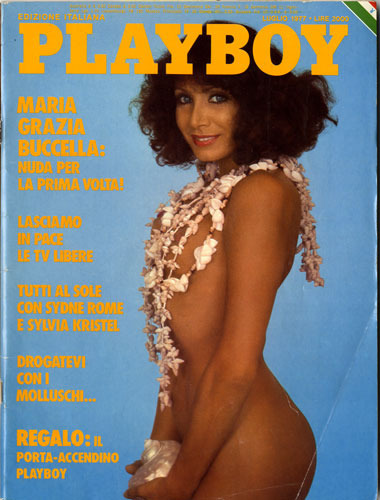
Source: Las Desperadas.
Playmen
In 1968, Maria Grazia Buccella won a Silver Ribbon award at the Italian National Syndicate of Film Journalists for Best Supporting Actress in the film Ti ho sposato per allegria/I Married You for Fun (Luciano Salce, 1967). She had the female lead in the American Western Villa Rides (Buzz Kulik, 1968) starring Yul Brynner as Pancho Villa. In the situation comedy Sissignore (Ugo Tognazzi, 1968) her co-star and director was Ugo Tognazzi. And she was one of the beautiful women around the young Giacomo Casanova (Leonard Whiting) in Infanzia, vocazione e prime esperienze di Giacomo Casanova, veneziano/Giacomo Casanova: Childhood and Adolescence (Luigi Comencini, 1969). During the 1970s, she played in genre films, such as the Spaghetti Western La collera del vento/ The Wind's Anger (Mario Camus, 1970) starring Terence Hill. In Il provincial/The Provincial (Luciano Salce, 1971), she played a callgirl who seduces provincial Gianni Morandi. After an interval in her career, she featured on the cover of Playmen magazine in November 1976, and a year later she appeared in the Italian Playboy. But her following films were only minor comedies. Buccella recorded some songs like Ballo del Popo (The dance of Poo, 1978) which she performed in revealing dresses on Italian TV shows. She virtually retired from film in 1979 although she made two small appearances in the 1980s. Her final appearance was in the film Hotel Otello (Andrea Biagini, Leonardo Scucchi, 2000). For years, she was the girlfriend of film producer Vittorio Cecchi Gori.
Maria Grazia Buccella does a striptease in Canzoni in... bikini/Songs in Bikini (Giuseppe Vari, 1963). Source: fardonrocknroll (YouTube).
Scenes from Ti ho sposato per allegria/I Married You for Fun (Luciano Salce, 1967). Source: afirelnd (YouTube).
Source: Las Desperadas (Italian), Wikipedia (Italian and English) and

Yugoslavian postcard by Cik Razglednica. Photo: publicity still for Sissignore (Ugo Tognazzi, 1968).
Miss Universe
Maria Grazia Buccella was born in Milan, Italy in 1940. At 11, she made her film debut with a bit role in the French-Italian crime drama Le cap de l'espérance/The Cape of Hope (Raymond Bernard, 1951), starring Edwige Feuillère. At 17 she was chosen as Miss Venezia Tridentina. In 1959, she was one of the contestants of the Miss Italy contest. She represented Italy at the Miss Europe contest, where she came in third, and at the Miss Universe contest. After that she started to play small parts in films again. Her first bigger role was in the comedy Fontana di Trevi/Fountain of Trevi (Carlo Campogalliani, 1960) with Claudio Villa. In the following years, she played big roles in forgettable comedies and a small part in Il boom/The Boom (Vittorio De Sica, 1963) starring Alberto Sordi. Other films were Cover Girls (José Bénazéraf, 1964) with Giorgia Moll, and Menage all'italiana/Menage Italian Style (Franco Indovina, 1965) with Ugo Tognazzi. She screentested for the role of Domino Derval in the James Bond film Thunderball (Terence Young, 1965), but the role eventually went to French actress, Claudine Auger. That year, she appeared in the Italian film Il Gaucho/The Gaucho (Dino Risi, 1965) which co-starred Vittorio Gassman. She appeared with Gassman again in the comedy Una vergine per il principe/A Maiden for a Prince (Pasquale Festa Campanile, 1966) and in the action comedy L'armata Brancaleone/For Love and Gold (Mario Monicelli, 1966). That year, she also played the beauty Miss Okra in the Peter Sellers film Caccia alla volpe/After the Fox (Vittorio De Sica, 1966).

Source: Las Desperadas.
Playmen
In 1968, Maria Grazia Buccella won a Silver Ribbon award at the Italian National Syndicate of Film Journalists for Best Supporting Actress in the film Ti ho sposato per allegria/I Married You for Fun (Luciano Salce, 1967). She had the female lead in the American Western Villa Rides (Buzz Kulik, 1968) starring Yul Brynner as Pancho Villa. In the situation comedy Sissignore (Ugo Tognazzi, 1968) her co-star and director was Ugo Tognazzi. And she was one of the beautiful women around the young Giacomo Casanova (Leonard Whiting) in Infanzia, vocazione e prime esperienze di Giacomo Casanova, veneziano/Giacomo Casanova: Childhood and Adolescence (Luigi Comencini, 1969). During the 1970s, she played in genre films, such as the Spaghetti Western La collera del vento/ The Wind's Anger (Mario Camus, 1970) starring Terence Hill. In Il provincial/The Provincial (Luciano Salce, 1971), she played a callgirl who seduces provincial Gianni Morandi. After an interval in her career, she featured on the cover of Playmen magazine in November 1976, and a year later she appeared in the Italian Playboy. But her following films were only minor comedies. Buccella recorded some songs like Ballo del Popo (The dance of Poo, 1978) which she performed in revealing dresses on Italian TV shows. She virtually retired from film in 1979 although she made two small appearances in the 1980s. Her final appearance was in the film Hotel Otello (Andrea Biagini, Leonardo Scucchi, 2000). For years, she was the girlfriend of film producer Vittorio Cecchi Gori.
Maria Grazia Buccella does a striptease in Canzoni in... bikini/Songs in Bikini (Giuseppe Vari, 1963). Source: fardonrocknroll (YouTube).
Scenes from Ti ho sposato per allegria/I Married You for Fun (Luciano Salce, 1967). Source: afirelnd (YouTube).
Source: Las Desperadas (Italian), Wikipedia (Italian and English) and
Published on July 30, 2013 23:00
July 29, 2013
Campari
Campari is a dark red-coloured apertivo, introduced in Italy in the 1860s by Gaspare Campari. A bitter, which is obtained from the infusion of herbs and fruit (including chinotto and cascarilla) in alcohol and water. In 1904, Campari's first production plant was opened in Sesto San Giovanni, near Milan, Italy. Under the direction of Davide Campari, Gaspare's son, the company began to export the beverage, first to Nice in the heart of the French Riviera, then overseas. Visual representation has been the cornerstone of brand Campari since the late 1880s. In the 1920s, a French postcard campaign with stars of the French silent cinema linked Campari to Paris. Recently Campari had print and television collaborations with film stars like Salma Hayek, Jessica Alba and Benicio del Toro.
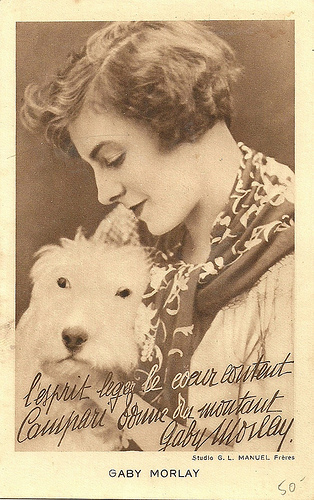
Gaby Morlay. French postcard. Photo G.L. Manuel Frères. Caption: "L'esprit léger, le coeur content, Campari donne du montant." (The spirit is light, the heart is satisfied, Campari gives the amount.)
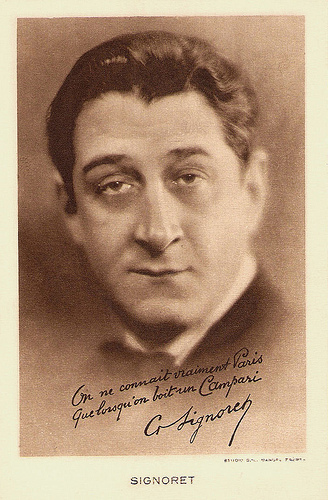
Gabriel Signoret. French postcard. Photo: Studio G.L. Manuel Frères. Caption: "One ne connait vraiment Paris que lorsqu'on boit un Campari." (One only really knows Paris when drinking a Campari).

Dranem. French postcard. Photo Studio G.L. Manuel Frères. Caption: "Quand Paris est la ville lumière, Campari est le Roi des Amers." (If Paris is the City of Light, Campari is the King of Bitters.)
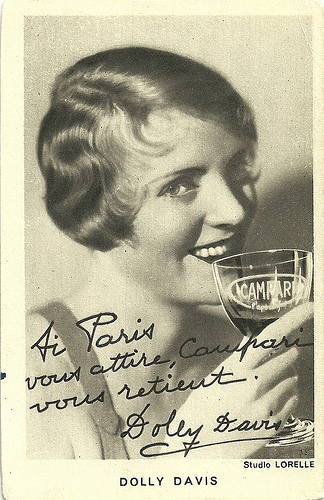
Dolly Davis. French postcard. Photo: Studio Lorelle. Caption: "Si Paris vous attire, Campari vous retient." (If Paris attracts you, Campari holds you back.)
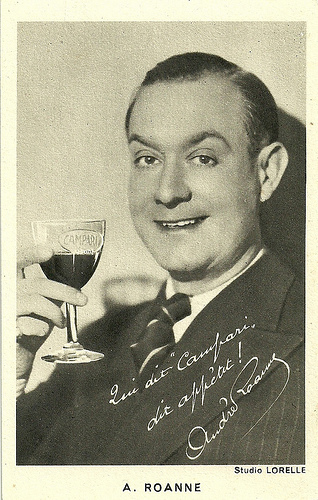
André Roanne. French postcard. Photo: Studio Lorelle. Caption: "Qui dit Campari, dit appétit!" (Who says Campari, says appetite!)
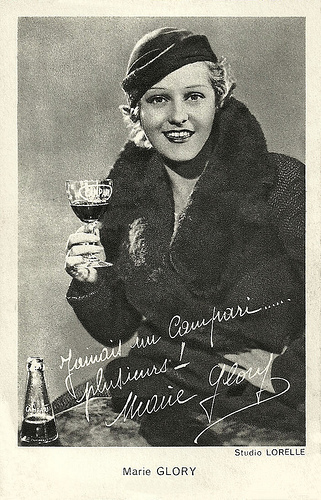
Marie Glory. French postcard. Photo: Studio Lorelle. Caption: "J'aimais un Campari... plusieurs!" (I would like 'Campari'... several!)
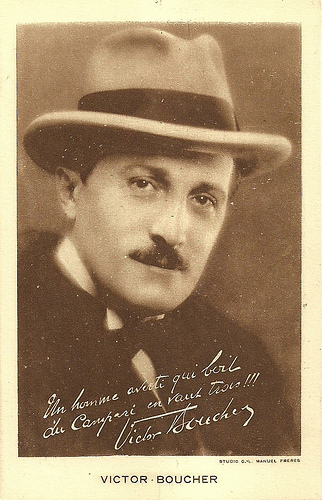
Victor Boucher. French postcard. Photo: Studio G.L. Manuel Frères. Caption: "Un homme averti qui boit du Campari en vaut trois!!!" (An informed man drinking Campari is worth three!!!)
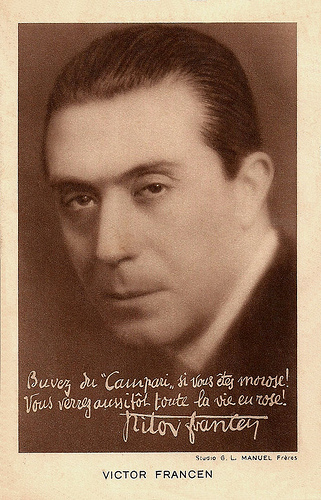
Victor Francen. French postcard. Photo: Studio G.L. Manuel Frères. Caption: "Buvez du 'Campari', si vous êtes morose! Vous verrez aussitôt la vie en rose!" (Drink 'Campari', if you are depressed! You immediately see life in pink!)
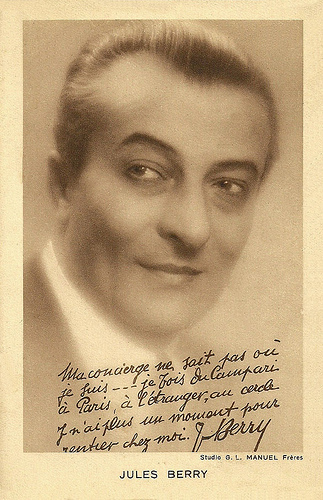
Jules Berry. French postcard. Photo: Studio G.L. Manuel Frères. Caption: "Ma concierge ne sait pas où je suis... je bois du Campari à Paris, à l'étranger, au cercle. Je n'ai plus un moment pour rentrer chez moi." (My concierge does not know where I am ... I drink Campari in Paris, abroad, at the club. I do not have time to go home anymore.)
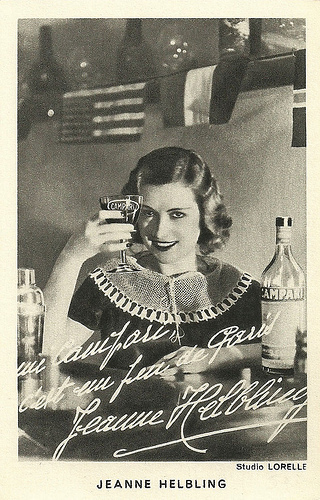
Jeanne Helbling. French postcard for Campari. Photo: Studio Lorelle. Caption: "Un Campari, c'est un peu de Paris." (A Campari is like a bit of Paris).
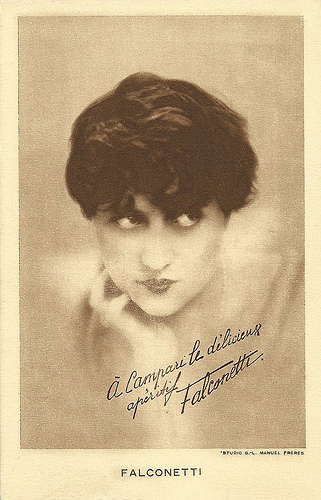
Maria Falconetti. French postcard. Photo: Studio G.L. Manuel Frères. Caption: "Á Campari le délicieux aperitif" (To Campari, the delicious aperitif).
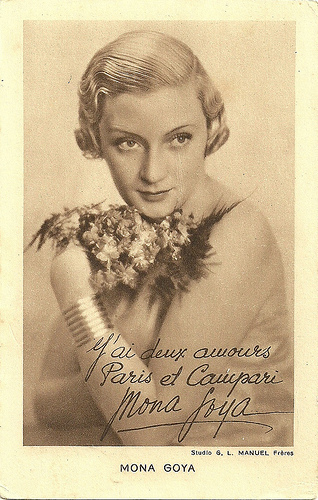
Mona Goya. French postcard. Photo: Studio G.L. Manuel Frères. Caption: "J'ai deux amours Paris et Campari." (I have two loves, Paris and Campari.)
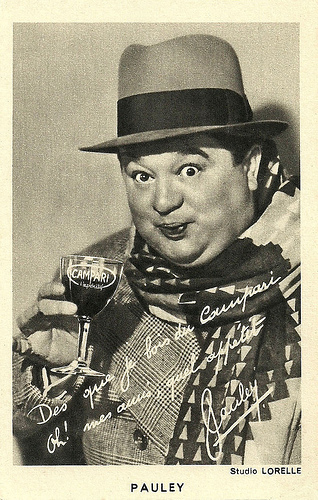
Pauley. French postcard for Campari. Photo: Studio Lorelle. Caption: "Dès que je bois du Campari, Oh! mes amis, quel appetit!" (Ever since I drink Campari, oh my friends, what an appetite!).
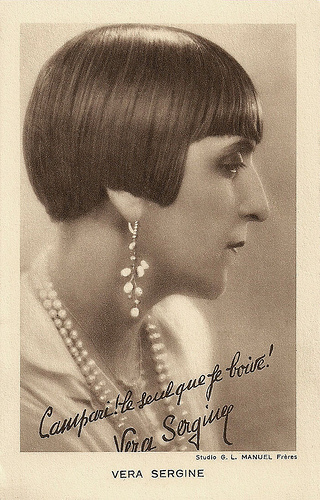
Vera Sergine. French postcard. Photo: Studio G.L. Manuel Frères. Caption: "Campari! Le seul que je boive!" (Campari! The only one I drink!)
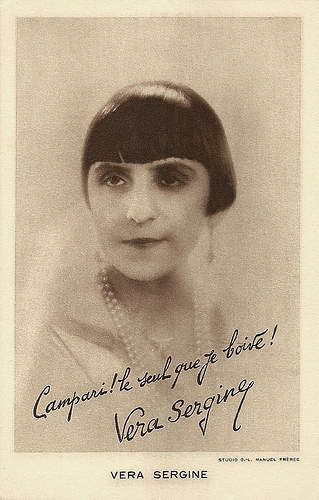
Vera Sergine. French postcard. Photo: Studio G.L. Manuel Frères. Caption: "Campari! Le seul que je boive!" (Campari! The only one I drink!)
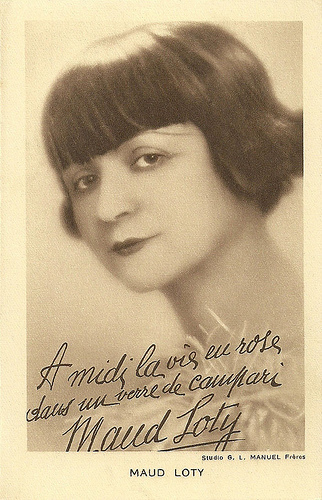
Maud Loty. French postcard. Photo: Studio G.L. Manuel Frères. Caption: "A midi la vie en rose dans un verre de Campari." (At noon, 'la vie en rose' in a glass of Campari.)
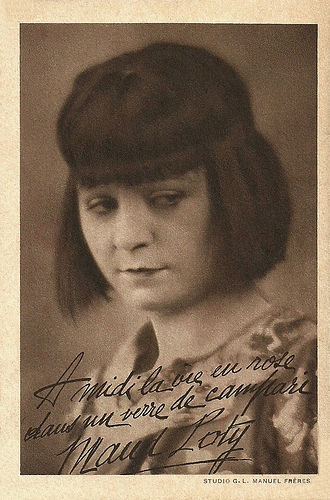
Maud Loty. French postcard. Photo: Studio G.L. Manuel Frères. Caption: "A midi la vie en rose dans un verre de Campari." (At noon, 'la vie en rose' in a glass of Campari.)
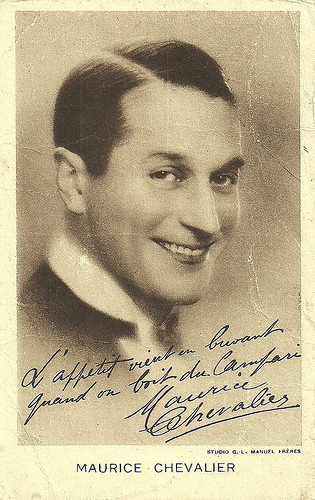
Maurice Chevalier. French postcard. Photo: G.L. Manuel Frères. Caption: "L'appetit vient en buvant, quand on boit du Campari." (When drinking Campari, the appetite comes.)
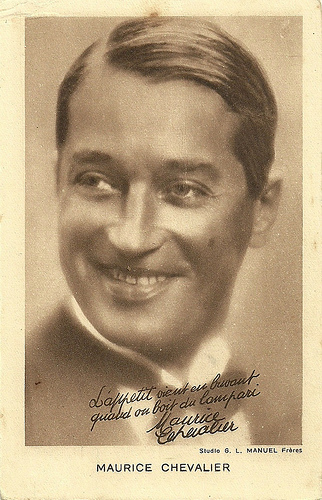
Maurice Chevalier. French postcard. Photo: G.L. Manuel Frères. Caption: "L'appetit vient en buvant, quand on boit du Campari." (When drinking Campari, the appetite comes.)
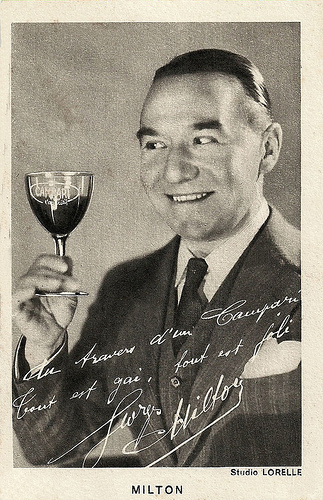
Georges Milton. French postcard. Photo: Studio Lorelle. Caption: "Au travers d'un Campari, Tout est gai, tout est joli." (With a Campari, all is gay, all is nice).
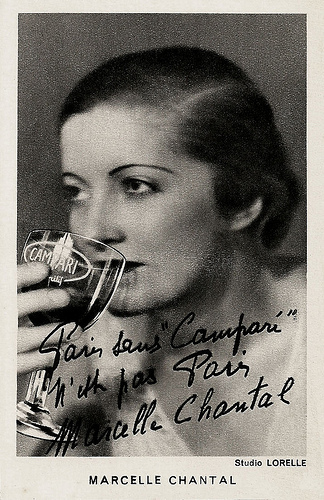
Marcelle Chantal. French postcard. Photo: Studio Lorelle. Caption: "Paris sans Campari, n'est pas Paris." (Paris without Campari isn't Paris.)
Sources: Tonique and Wikipedia.

Gaby Morlay. French postcard. Photo G.L. Manuel Frères. Caption: "L'esprit léger, le coeur content, Campari donne du montant." (The spirit is light, the heart is satisfied, Campari gives the amount.)

Gabriel Signoret. French postcard. Photo: Studio G.L. Manuel Frères. Caption: "One ne connait vraiment Paris que lorsqu'on boit un Campari." (One only really knows Paris when drinking a Campari).

Dranem. French postcard. Photo Studio G.L. Manuel Frères. Caption: "Quand Paris est la ville lumière, Campari est le Roi des Amers." (If Paris is the City of Light, Campari is the King of Bitters.)

Dolly Davis. French postcard. Photo: Studio Lorelle. Caption: "Si Paris vous attire, Campari vous retient." (If Paris attracts you, Campari holds you back.)

André Roanne. French postcard. Photo: Studio Lorelle. Caption: "Qui dit Campari, dit appétit!" (Who says Campari, says appetite!)

Marie Glory. French postcard. Photo: Studio Lorelle. Caption: "J'aimais un Campari... plusieurs!" (I would like 'Campari'... several!)

Victor Boucher. French postcard. Photo: Studio G.L. Manuel Frères. Caption: "Un homme averti qui boit du Campari en vaut trois!!!" (An informed man drinking Campari is worth three!!!)

Victor Francen. French postcard. Photo: Studio G.L. Manuel Frères. Caption: "Buvez du 'Campari', si vous êtes morose! Vous verrez aussitôt la vie en rose!" (Drink 'Campari', if you are depressed! You immediately see life in pink!)

Jules Berry. French postcard. Photo: Studio G.L. Manuel Frères. Caption: "Ma concierge ne sait pas où je suis... je bois du Campari à Paris, à l'étranger, au cercle. Je n'ai plus un moment pour rentrer chez moi." (My concierge does not know where I am ... I drink Campari in Paris, abroad, at the club. I do not have time to go home anymore.)

Jeanne Helbling. French postcard for Campari. Photo: Studio Lorelle. Caption: "Un Campari, c'est un peu de Paris." (A Campari is like a bit of Paris).

Maria Falconetti. French postcard. Photo: Studio G.L. Manuel Frères. Caption: "Á Campari le délicieux aperitif" (To Campari, the delicious aperitif).

Mona Goya. French postcard. Photo: Studio G.L. Manuel Frères. Caption: "J'ai deux amours Paris et Campari." (I have two loves, Paris and Campari.)

Pauley. French postcard for Campari. Photo: Studio Lorelle. Caption: "Dès que je bois du Campari, Oh! mes amis, quel appetit!" (Ever since I drink Campari, oh my friends, what an appetite!).

Vera Sergine. French postcard. Photo: Studio G.L. Manuel Frères. Caption: "Campari! Le seul que je boive!" (Campari! The only one I drink!)

Vera Sergine. French postcard. Photo: Studio G.L. Manuel Frères. Caption: "Campari! Le seul que je boive!" (Campari! The only one I drink!)

Maud Loty. French postcard. Photo: Studio G.L. Manuel Frères. Caption: "A midi la vie en rose dans un verre de Campari." (At noon, 'la vie en rose' in a glass of Campari.)

Maud Loty. French postcard. Photo: Studio G.L. Manuel Frères. Caption: "A midi la vie en rose dans un verre de Campari." (At noon, 'la vie en rose' in a glass of Campari.)

Maurice Chevalier. French postcard. Photo: G.L. Manuel Frères. Caption: "L'appetit vient en buvant, quand on boit du Campari." (When drinking Campari, the appetite comes.)

Maurice Chevalier. French postcard. Photo: G.L. Manuel Frères. Caption: "L'appetit vient en buvant, quand on boit du Campari." (When drinking Campari, the appetite comes.)

Georges Milton. French postcard. Photo: Studio Lorelle. Caption: "Au travers d'un Campari, Tout est gai, tout est joli." (With a Campari, all is gay, all is nice).

Marcelle Chantal. French postcard. Photo: Studio Lorelle. Caption: "Paris sans Campari, n'est pas Paris." (Paris without Campari isn't Paris.)
Sources: Tonique and Wikipedia.
Published on July 29, 2013 23:00
Paul van Yperen's Blog
- Paul van Yperen's profile
- 13 followers
Paul van Yperen isn't a Goodreads Author
(yet),
but they
do have a blog,
so here are some recent posts imported from
their feed.



